Feed aggregator
Dishhhwashhher

My dearest BDH,
I come to this keyboard today to write to you that we are well. It has been 8 days without a working dishwasher. It is but by the grace of the higher power that we are surviving this crisis. Hope alone sustains us through these dark times, hope that a new dishwasher shall arrive today between the hours of 01:00 PM and 05:00 PM from Wilson Appliances.
Forever yours and deep in dishes,
Ilona, Your Loving Author.
The trouble with the dishwasher started as soon as we came back from vacation. After we got home, I marinated some chicken, and ended up with a load of dishes that had a big glass marinading dish in it.
I start the dishwasher. It gets through part of the cycle. I come back to the kitchen.
DRAIN.
Okay. I have done this song and dance before. I open the dishwasher full of nasty chicken water. Ugh. I get gloves, scoop the water out, take out the filter, clean it out – it’s clean, put it back in, hit the rinse and hold cycle.
DRAIN.
Grrr. I opened the dishwasher, scoop the nasty water out for the second time, remove filter, undo the plastic doohicky that protects a little fan. Sometimes stuff gets stuck under there, preventing the fan from rotating. The fan is clear. Nothing is stuck. Rinse and hold.
DRAIN.
*$##$%%^%$%^.
At that point it was late at night and I didn’t want to wrestle with the chicken water again, so I gave up.
Morning found Gordon messing with the dishwasher. He scooped the chicken water out, checked the filter, checked the fan.
DRAIN.
Maybe there was some grease accumulated somewhere and now things are clogged. We boil water, pour it into the dishwasher. The dishwasher drains. YES! Start the rinse and hold.
DRAIN.
More boiling water.
DRAIN.
DRAIN.
We hoped to have the dishwasher repaired, but nobody works on this brand. We did have a plumber out to check is the hose had clogged.
Plumber: It seems like the motor. How old is this dishwasher?
Gordon: 27 years.
Plumber: This might have something to do with your current problem.
So we bought a new dishwasher. In other news, I have finally finished the nobody knows how old bottle of Dawn’s dishwashing liquid that had been living alone in the dark under the sink.
The house is coming up on 30 years, and so far in the last 18 months the range quit, the fridge bit the dust, and now the dishwasher died.
::eyes the dual ovens::
Between you and me, if they die, I wouldn’t mind, because they are old and the temperature control is questionable. I’m pretty sure 375 is no longer 375. But we are keeping them until they die. They have got to hold on till the mid-fall at least. The Inheritance Buys New Ovens royalties should come in then.
Our smart thermostat quit, but we fixed it and Kid 1’s microwave gave up the ghost, so that concludes the trilogy of appliance breaking. These repairs usually come in threes, so let’s hope this cluster is behind us.
Here is hoping your appliances work well and last way past the manufacturer’s suggested lifecycle.
The post Dishhhwashhher first appeared on ILONA ANDREWS.
18 Lectures in “Immemorial” Shine A Light | Making Memories For Our Future
Immemorial is a synthesis of reporting, memoir, and essay, reflecting on the design and function…
The post 18 Lectures in “Immemorial” Shine A Light | Making Memories For Our Future appeared first on LitStack.
Free Fiction Monday: Red Letter Day
Graduation Day at Barack Obama High School. The day the Red Letters arrive. The day that students get a glimpse into their own future.
But a handful never get a letter, and no one knows why. One teacher comes up with an idea though: a teacher who never got a Red Letter herself, a teacher finally finds the answers to her own fate.
Called “a fresh, solid, entertaining take on time travel” by Tangent Online, “Red Letter Day” was chosen as the best short story by the readers of Analog Magazine.
“Red Letter Day“ is available for one week on this site. The ebook is available on all retail stores, as well as here.
Red Letter Day By Kristine Kathryn Rusch
Graduation rehearsal—middle of the afternoon on the final Monday of the final week of school. The graduating seniors at Barack Obama High School gather in the gymnasium, get the wrapped packages with their robes (ordered long ago), their mortarboards, and their blue and white tassels. The tassels attract the most attention—everyone wants to know which side of the mortarboard to wear it on, and which side to move it to.
The future hovers, less than a week away, filled with possibilities.
Possibilities about to be limited, because it’s also Red Letter Day.
I stand on the platform, near the steps, not too far from the exit. I’m wearing my best business casual skirt today and a blouse that I no longer care about. I learned to wear something I didn’t like years ago; too many kids will cry on me by the end of the day, covering the blouse with slobber and makeup and aftershave.
My heart pounds. I’m a slender woman, although I’m told I’m formidable. Coaches need to be formidable. And while I still coach the basketball teams, I no longer teach gym classes because the folks in charge decided I’d be a better counselor than gym teacher. They made that decision on my first Red Letter Day at BOHS, more than twenty years ago.
I’m the only adult in this school who truly understands how horrible Red Letter Day can be. I think it’s cruel that Red Letter Day happens at all, but I think the cruelty gets compounded by the fact that it’s held in school.
Red Letter Day should be a holiday, so that kids are at home with their parents when the letters arrive.
Or don’t arrive, as the case may be.
And the problem is that we can’t even properly prepare for Red Letter Day. We can’t read the letters ahead of time: privacy laws prevent it.
So do the strict time travel rules. One contact—only one—through an emissary, who arrives shortly before rehearsal, stashes the envelopes in the practice binders, and then disappears again. The emissary carries actual letters from the future. The letters themselves are the old-fashioned paper kind, the kind people wrote 150 years ago, but write rarely now. Only the real letters, handwritten, on special paper get through. Real letters, so that the signatures can be verified, the paper guaranteed, the envelopes certified.
Apparently, even in the future, no one wants to make a mistake.
The binders have names written across them so the letter doesn’t go to the wrong person. And the letters are supposed to be deliberately vague.
I don’t deal with the kids who get letters. Others are here for that, some professional bullshitters—at least in my opinion. For a small fee, they’ll examine the writing, the signature, and try to clear up the letter’s deliberate vagueness, make a guess at the socio-economic status of the writer, the writer’s health, or mood.
I think that part of Red Letter Day makes it all a scam. But the schools go along with it, because the counselors (read: me) are busy with the kids who get no letter at all.
And we can’t predict whose letter won’t arrive. We don’t know until the kid stops mid-stride, opens the binder, and looks up with complete and utter shock.
Either there’s a red envelope inside or there’s nothing.
And we don’t even have time to check which binder is which.
***
I had my Red Letter Day thirty-two years ago, in the chapel of Sister Mary of Mercy High School in Shaker Heights, Ohio. Sister Mary of Mercy was a small co-ed Catholic High School, closed now, but very influential in its day. The best private school in Ohio according to some polls—controversial only because of its conservative politics and its willingness to indoctrinate its students.
I never noticed the indoctrination. I played basketball so well that I already had three full-ride scholarship offers from UCLA, UNLV, and Ohio State (home of the Buckeyes!). A pro scout promised I’d be a fifth round draft choice if only I went pro straight out of high school, but I wanted an education.
“You can get an education later,” he told me. “Any good school will let you in after you’ve made your money and had your fame.”
But I was brainy. I had studied athletes who went to the Bigs straight out of high school. Often they got injured, lost their contracts and their money, and never played again. Usually they had to take some crap job to pay for their college education—if, indeed, they went to college at all, which most of them never did.
Those who survived lost most of their earnings to managers, agents, and other hangers’ on. I knew what I didn’t know. I knew I was an ignorant kid with some great ball-handling ability. I knew that I was trusting and naïve and undereducated. And I knew that life extended well beyond thirty-five, when even the most gifted female athletes lost some of their edge.
I thought a lot about my future. I wondered about life past thirty-five. My future self, I knew, would write me a letter fifteen years after thirty-five. My future self, I believed, would tell me which path to follow, what decision to make.
I thought it all boiled down to college or the pros.
I had no idea there would be—there could be—anything else.
You see, anyone who wants to—anyone who feels so inclined—can write one single letter to their former self. The letter gets delivered just before high school graduation, when most teenagers are (theoretically) adults, but still under the protection of a school.
The recommendations on writing are that the letter should be inspiring. Or it should warn that former self away from a single person, a single event, or a one single choice.
Just one.
The statistics say that most folks don’t warn. They like their lives as lived. The folks motivated to write the letters wouldn’t change much, if anything.
It’s only those who’ve made a tragic mistake—one drunken night that led to a catastrophic accident, one bad decision that cost a best friend a life, one horrible sexual encounter that led to a lifetime of heartache—who write the explicit letter.
And the explicit letter leads to alternate universes. Lives veer off in all kinds of different paths. The adult who sends the letter hopes their former self will take their advice. If the former self does take the advice, then the kid who receives the letter from an adult they will never be. The kid, if smart, will become a different adult, the adult who somehow avoided that drunken night. That new adult will write a different letter to their former self, warning about another possibility or committing bland, vague prose about a glorious future.
There’re all kinds of scientific studies about this, all manner of debate about the consequences. All types of mandates, all sorts of rules.
And all of them lead back to that moment, that heart stopping moment that I experienced in the chapel of Sister Mary of Mercy High School, all those years ago.
We weren’t practicing graduation like the kids at Barack Obama High School. I don’t recall when we practiced graduation, although I’m sure we had a practice later in the week.
At Sister Mary of Mercy High School, we spent our Red Letter Day in prayer. All the students started their school days with Mass. But on Red Letter Day, the graduating seniors had to stay for a special service, marked by requests for God’s forgiveness and exhortations about the unnaturalness of what the law required Sister Mary of Mercy to do.
Sister Mary of Mercy High School loathed Red Letter Day. In fact, Sister Mary of Mercy High School, as an offshoot of the Catholic Church, opposed time travel altogether. Back in the dark ages (in other words, decades before I was born), the Catholic Church declared time travel an abomination, antithetical to God’s will.
You know the arguments: If God had wanted us to travel through time, the devout claim, he would have given us the ability to do so. If God had wanted us to travel through time, the scientists say, he would have given us the ability to understand time travel—and oh! Look! He’s done that.
Even now, the arguments devolve from there.
But time travel has become a fact of life for the rich and the powerful and the well-connected. The creation of alternate universes scares them less than the rest of us, I guess. Or maybe the rich really don’t care—they being different from you and I, as renowned (but little read) 20th Century American author F. Scott Fitzgerald so famously said.
The rest of us—the non-different ones—realized nearly a century ago that time travel for all was a dicey proposition, but this being America, we couldn’t deny people the opportunity of time travel.
Eventually time travel for everyone became a rallying cry. The liberals wanted government to fund it, and the conservatives felt only those who could afford it would be allowed to have it.
Then something bad happened—something not quite expunged from the history books, but something not taught in schools either (or at least the schools I went to), and the federal government came up with a compromise.
Everyone would get one free opportunity for time travel—not that they could actually go back and see the crucifixion or the Battle of Gettysburg—but that they could travel back in their own lives.
The possibility for massive change was so great, however, that the time travel had to be strictly controlled. All the regulations in the world wouldn’t stop someone who stood in Freedom Hall in July of 1776 from telling the Founding Fathers what they had wrought.
So the compromise got narrower and narrower (with the subtext being that the masses couldn’t be trusted with something as powerful as the ability to travel through time), and it finally became Red Letter Day, with all its rules and regulations. You’d have the ability to touch your own life without ever really leaving it. You’d reach back into your own past and reassure yourself, or put something right.
Which still seemed unnatural to the Catholics, the Southern Baptists, the Libertarians, and the Stuck in Time League (always my favorite, because they never did seem to understand the irony of their own name). For years after the law passed, places like Sister Mary of Mercy High School tried not to comply with it. They protested. They sued. They got sued.
Eventually, when the dust settled, they still had to comply.
But they didn’t have to like it.
So they tortured all of us, the poor hopeful graduating seniors, awaiting our future, awaiting our letters, awaiting our fate.
I remember the prayers. I remember kneeling for what seemed like hours. I remember the humidity of that late spring day, and the growing heat, because the chapel (a historical building) wasn’t allowed to have anything as unnatural as air conditioning.
Martha Sue Groening passed out, followed by Warren Iverson, the star quarterback. I spent much of that morning with my forehead braced against the pew in front of me, my stomach in knots.
My whole life, I had waited for this moment.
And then, finally, it came. We went alphabetically, which stuck me in the middle, like usual. I hated being in the middle. I was tall, geeky, uncoordinated, except on the basketball court, and not very developed—important in high school. And I wasn’t formidable yet.
That came later.
Nope. Just a tall awkward girl, walking behind boys shorter than I was. Trying to be inconspicuous.
I got to the aisle, watching as my friends stepped in front of the altar, below the stairs where we knelt when we went up for the sacrament of communion.
Father Broussard handed out the binders. He was tall but not as tall as me. He was tending to fat, with most of it around his middle. He held the binders by the corner, as if the binders themselves were cursed, and he said a blessing over each and every one of us as we reached out for our futures.
We weren’t supposed to say anything, but a few of the boys muttered, “Sweet!” and some of the girls clutched their binders to their chests as if they’d received a love letter.
I got mine—cool and plastic against my fingers—and held it tightly. I didn’t open it, not near the stairs, because I knew the kids who hadn’t gotten theirs yet would watch me.
So I walked all the way to the doors, stepped into the hallway, and leaned against the wall.
Then I opened my binder.
And saw nothing.
My breath caught.
I peered back into the chapel. The rest of the kids were still in line, getting their binders. No red envelopes had landed on the carpet. No binders were tossed aside.
Nothing. I stopped three of the kids, asking them if they saw me drop anything or if they’d gotten mine.
Then Sister Mary Catherine caught my arm, and dragged me away from the steps. Her fingers pinched into the nerve above my elbow, sending a shooting pain down to my hand.
“You’re not to interrupt the others,” she said.
“But I must have dropped my letter.”
She peered at me, then let go of my arm. A look of satisfaction crossed her fat face, then she patted my cheek.
The pat was surprisingly tender.
“Then you are blessed,” she said.
I didn’t feel blessed. I was about to tell her that, when she motioned Father Broussard over.
“She received no letter,” Sister Mary Catherine said.
“God has smiled on you, my child,” he said warmly. He hadn’t noticed me before, but this time, he put his hand on my shoulder. “You must come with me to discuss your future.”
I let him lead me to his office. The other nuns—the ones without a class that hour—gathered with him. They talked to me about how God wanted me to make my own choices, how He had blessed me by giving me back my future, how He saw me as without sin.
I was shaking. I had looked forward to this day all my life—at least the life I could remember—and then this. Nothing. No future. No answers.
Nothing.
I wanted to cry, but not in front of Father Broussard. He had already segued into a discussion of the meaning of the blessing. I could serve the church. Anyone who failed to get a letter got free admission into a variety of colleges and universities, all Catholic, some well known. If I wanted to become a nun, he was certain the church could accommodate me.
“I want to play basketball, Father,” I said.
He nodded. “You can do that at any of these schools.”
“Professional basketball,” I said.
And he looked at me as if I were the spawn of Satan.
“But, my child,” he said with a less reasonable tone than before, “you have received a sign from God. He thinks you Blessed. He wants you in his service.”
“I don’t think so,” I said, my voice thick with unshed tears. “I think you made a mistake.”
Then I flounced out of his office, and off school grounds.
My mother made me go back for the last four days of class. She made me graduate. She said I would regret it if I didn’t.
I remember that much.
But the rest of the summer was a blur. I mourned my known future, worried I would make the wrong choices, and actually considered the Catholic colleges. My mother rousted me enough to get me to choose before the draft. And I did.
The University of Nevada in Las Vegas, as far from the Catholic Church as I could get.
I took my full ride, and destroyed my knee in my very first game. God’s punishment, Father Broussard said when I came home for Thanksgiving.
And God forgive me, I actually believed him.
But I didn’t transfer—and I didn’t become Job, either. I didn’t fight with God or curse God. I abandoned Him because, as I saw it, He had abandoned me.
***
Thirty-two years later, I watch the faces. Some flush. Some look terrified. Some burst into tears.
But some just look blank, as if they’ve received a great shock.
Those students are mine.
I make them stand beside me, even before I ask them what they got in their binder. I haven’t made a mistake yet, not even last year, when I didn’t pull anyone aside.
Last year, everyone got a letter. That happens every five years or so. All the students get Red Letters, and I don’t have to deal with anything.
This year, I have three. Not the most ever. The most ever was thirty, and within five years it became clear why. A stupid little war in a stupid little country no one had ever heard of. Twenty-nine of my students died within the decade. Twenty-nine.
The thirtieth was like me, someone who has not a clue why her future self failed to write her a letter.
I think about that, as I always do on Red Letter Day.
I’m the kind of person who would write a letter. I have always been that person. I believe in communication, even vague communication. I know how important it is to open that binder and see that bright red envelope.
I would never abandon my past self.
I’ve already composed drafts of my letter. In two weeks—on my fiftieth birthday—some government employee will show up at my house to set up an appointment to watch me write the letter.
I won’t be able to touch the paper, the red envelope or the special pen until I agree to be watched. When I finish, the employee will fold the letter, tuck it in the envelope and earmark it for Sister Mary of Mercy High School in Shaker Heights, Ohio, thirty-two years ago.
I have plans. I know what I’ll say.
But I still wonder why I didn’t say it to my previous self. What went wrong? What prevented me? Am I in an alternate universe already and I just don’t know it?
Of course, I’ll never be able to find out.
But I set that thought aside. The fact that I did not receive a letter means nothing. It doesn’t mean that I’m blessed by God any more than it means I’ll fail to live to fifty.
It is a trick, a legal sleight of hand, so that people like me can’t travel to the historical bright spots or even visit the highlights of their own past life.
I continue to watch faces, all the way to the bitter end. But I get no more than three. Two boys and a girl.
Carla Nelson. A tall, thin, white-haired blonde who ran cross-country and stayed away from basketball, no matter how much I begged her to join the team. We needed height and we needed athletic ability.
She has both, but she told me, she isn’t a team player. She wanted to run and run alone. She hated relying on anyone else.
Not that I blame her.
But from the devastation on her angular face, I can see that she relied on her future self. She believed she wouldn’t let herself down.
Not ever.
Over the years, I’ve watched other counselors use platitudes. I’m sure it’s nothing. Perhaps your future self felt that you’re on the right track. I’m sure you’ll be fine.
I was bitter the first time I watched the high school kids go through this ritual. I never said a word, which was probably a smart decision on my part, because I silently twisted my colleagues’ platitudes into something negative, something awful, inside my own head.
It’s something. We all know it’s something. Your future self hates you or maybe—probably—you’re dead.
I have thought all those things over the years, depending on my life. Through a checkered college career, an education degree, a marriage, two children, a divorce, one brand new grandchild. I have believed all kinds of different things.
At thirty-five, when my hopeful young self thought I’d be retiring from pro ball, I stopped being a gym teacher and became a full time counselor. A full time counselor and occasional coach.
I told myself I didn’t mind.
I even wondered what would I write if I had the chance to play in the Bigs? Stay the course? That seems to be the most common letter in those red envelopes. It might be longer than that, but it always boils down to those three words.
Stay the course.
Only I hated the course. I wonder: would I have blown my knee out in the Bigs? Would I have made the Bigs? Would I have received the kind of expensive nanosurgery that would have kept my career alive? Or would I have washed out worse than I ever had?
Dreams are tricky things.
Tricky and delicate and easily destroyed.
And now I faced three shattered dreamers, standing beside me on the edge of the podium.
“To my office,” I say to the three of them.
They’re so shell-shocked that they comply.
I try to remember what I know about the boys. Esteban Rellier and J.J. Feniman. J.J. stands for…Jason Jacob. I remembered only because the names were so very old-fashioned, and J.J. was the epitome of modern cool.
If you had to choose which students would succeed based on personality and charm, not on Red Letters and opportunity, you would choose J.J.
You would choose Esteban with a caveat. He would have to apply himself.
If you had to pick anyone in class who wouldn’t write a letter to herself, you would pick Carla. Too much of a loner. Too prickly. Too difficult. I shouldn’t have been surprised that she’s coming with me.
But I am.
Because it’s never the ones you suspect who fail to get a letter.
It’s always the ones you believe in, the ones you have hopes for.
And somehow—now—it’s my job to keep those hopes alive.
***
I am prepared for this moment. I’m not a fan of interactive technology—feeds scrolling across the eye, scans on the palm of the hand—but I use it on Red Letter Day more than any other time during the year.
As we walk down the wide hallway to the administrative offices, I learn everything the school knows about all three students which, honestly, isn’t much.
Psych evaluations—including modified IQ tests—from grade school on. Addresses. Parental income and employment. Extracurriculars. Grades. Troubles (if any reported). Detentions. Citations. Awards.
I already know a lot about J.J. already. Homecoming king, quarterback, would’ve been class president if he hadn’t turned the role down. So handsome he even has his own stalker, a girl named Lizbet Cholene, whom I’ve had to discipline twice before sending to a special psych unit for evaluation.
I have to check on Esteban. He’s above average, but only in the subjects that interest him. His IQ tested high on both the old exam and the new. He has unrealized potential, and has never really been challenged, partly because he doesn’t seem to be the academic type.
It’s Carla who is still the enigma. IQ higher than either boy’s. Grades lower. No detentions, citations, or academic awards. Only the postings in cross country—continual wins, all state three years in a row, potential offers from colleges, if she brought her grades up, which she never did. Nothing on the parents. Address in a middle-class neighborhood, smack in the center of town.
I cannot figure her out in a three-minute walk, even though I try.
I usher them into my office. It’s large and comfortable. Big desk, upholstered chairs, real plants, and a view of the track—which probably isn’t the best thing right now, at least for Carla.
I have a speech that I give. I try not to make it sound canned.
“Your binders were empty, weren’t they?” I say.
To my surprise, Carla’s lower lip quivers. I thought she’d tough it out, but the tears are close to the surface. Esteban’s nose turns red and he bows his head. Carla’s distress makes it hard for him to control his.
J.J. leans against the wall, arms folded. His handsome face is a mask. I realize then how often I’d seen that look on his face. Not quite blank—a little pleasant—but detached, far away. He braces one foot on the wall, which is going to leave a mark, but I don’t call him on that. I just let him lean.
“On my Red Letter Day,” I say, “I didn’t get a letter either.”
They look at me in surprise. Adults aren’t supposed to discuss their letters with kids. Or their lack of letters. Even if I had been able to discuss it, I wouldn’t have.
I’ve learned over the years that this moment is the crucial one, the moment when they realize that you will survive the lack of a letter.
“Do you know why?” Carla asks, her voice raspy.
I shake my head. “Believe me, I’ve wondered. I’ve made up every scenario in my head—maybe I died before it was time to write the letter—”
“But you’re older than that now, right?” J.J. asks, with something of an angry edge. “You wrote the letter this time, right?”
“I’m eligible to write the letter in two weeks,” I say. “I plan to do it.”
His cheeks redden, and for the first time, I see how vulnerable he is beneath the surface. He’s as devastated—maybe more devastated—than Carla and Esteban. Like me, J.J. believed he would get the letter he deserved—something that told him about his wonderful, successful, very rich life.
“So you could still die before you write it,” he said, and this time, I’m certain he meant the comment to hurt.
It did. But I don’t let that emotion show on my face. “I could,” I say. “But I’ve lived for thirty-two years without a letter. Thirty-two years without a clue about what my future holds. Like people used to live before time travel. Before Red Letter Day.”
I have their attention now.
“I think we’re the lucky ones,” I say, and because I’ve established that I’m part of their group, I don’t sound patronizing. I’ve given this speech for nearly two decades, and previous students have told me that this part of the speech is the most important part.
Carla’s gaze meets mine, sad, frightened and hopeful. Esteban keeps his head down. J.J.’s eyes have narrowed. I can feel his anger now, as if it’s my fault that he didn’t get a letter.
“Lucky?” he asks in the same tone that he used when he reminded me I could still die.
“Lucky,” I say. “We’re not locked into a future.”
Esteban looks up now, a frown creasing his forehead.
“Out in the gym,” I say, “some of the counselors are dealing with students who’re getting two different kinds of tough letters. The first tough one is the one that warns you not to do something on such and so date or you’ll screw up your life forever.”
“People actually get those?” Esteban asks, breathlessly.
“Every year,” I say.
“What’s the other tough letter?” Carla’s voice trembles. She speaks so softly I had to strain to hear her.
“The one that says You can do better than I did, but won’t—can’t really—explain exactly what went wrong. We’re limited to one event, and if what went wrong was a cascading series of bad choices, we can’t explain that. We just have to hope that our past selves—you guys, in other words—will make the right choices, with a warning.”
J.J.’s frowning too. “What do you mean?”
“Imagine,” I say, “instead of getting no letter, you get a letter that tells you that none of your dreams come true. The letter tells you simply that you’ll have to accept what’s coming because there’s no changing it.”
“I wouldn’t believe it,” he says.
And I agree: he wouldn’t believe it. Not at first. But those wormy little bits of doubt would burrow in and affect every single thing he does from this moment on.
“Really?” I say. “Are you the kind of person who would lie to yourself in an attempt to destroy who you are now? Trying to destroy every bit of hope that you possess?”
His flush grows deeper. Of course he isn’t. He lies to himself—we all do—but he lies to himself about how great he is, how few flaws he has. When Lizbet started following him around, I brought him into my office and asked him not to pay attention to her.
It leads her on, I say.
I don’t think it does, he says. She knows I’m not interested.
He knew he wasn’t interested. Poor Lizbet had no idea at all.
I can see her outside now, hovering in the hallway, waiting for him, wanting to know what his letter said. She’s holding her red envelope in one hand, the other lost in the pocket of her baggy skirt. She looks prettier than usual, as if she’s dressed up for this day, maybe for the inevitable party.
Every year, some idiot plans a Red Letter Day party even though the school—the culture—recommends against it. Every year, the kids who get good letters go. And the other kids beg off, or go for a short time, and lie about what they received.
Lizbet probably wants to know if he’s going to go.
I wonder what he’ll say to her.
“Maybe you wouldn’t send a letter if the truth hurt too much,” Esteban says.
And so it begins, the doubts, the fears.
“Or,” I say, “if your successes are beyond your wild imaginings. Why let yourself expect that? Everything you do might freeze you, might lead you to wonder if you’re going to screw that up.”
They’re all looking at me again.
“Believe me,” I say. “I’ve thought of every single possibility, and they’re all wrong.”
The door to my office opens and I curse silently. I want them to concentrate on what I just said, not on someone barging in on us.
I turn.
Lizbet has come in. She looks like she’s on edge, but then she’s always on edge around J.J.
“I want to talk to you, J.J.” Her voice shakes.
“Not now,” he says. “In a minute.”
“Now,” she says. I’ve never heard this tone from her. Strong and scary at the same time.
“Lizbet,” J.J. says, and it’s clear he’s tired, he’s overwhelmed, he’s had enough of this day, this event, this girl, this school—he’s not built to cope with something he considers a failure. “I’m busy.”
“You’re not going to marry me,” she says.
“Of course not,” he snaps—and that’s when I know it. Why all four of us don’t get letters, why I didn’t get a letter, even though I’m two weeks shy from my fiftieth birthday and fully intend to send something to my poor past self.
Lizbet holds her envelope in one hand, and a small plastic automatic in the other. An illegal gun, one that no one should be able to get—not a student, not an adult. No one.
“Get down!” I shout as I launch myself toward Lizbet.
She’s already firing, but not at me. At J.J. who hasn’t gotten down.
But Esteban deliberately drops and Carla—Carla’s half a step behind me, launching herself as well.
Together we tackle Lizbet, and I pry the pistol from her hands. Carla and I hold her as people come running from all directions, some adults, some kids holding letters.
Everyone gathers. We have no handcuffs, but someone finds rope. Someone else has contacted emergency services, using the emergency link that we all have, that we all should have used, that I should have used, that I probably had used in another life, in another universe, one in which I didn’t write a letter. I probably contacted emergency services and said something placating to Lizbet, and she probably shot all four of us, instead of poor J.J.
J.J., who is motionless on the floor, his blood slowly pooling around him. The football coach is trying to stop the bleeding and someone I don’t recognize is helping and there’s nothing I can do, not at the moment, they’re doing it all while we wait for emergency services.
The security guard ties up Lizbet and sets the gun on the desk and we all stare at it, and Annie Sanderson, the English teacher, says to the guard, “You’re supposed to check everyone, today of all days. That’s why we hired you.”
And the principal admonishes her, tiredly, and she shuts up. Because we know that sometimes Red Letter Day causes this, that’s why it’s held in school, to stop family annihilations and shootings of best friends and employers. Schools, we’re told, can control weaponry and violence, even though they can’t, and someone, somewhere, will use this as a reason to repeal Red Letter Day, but all those people who got good letters or letters warning them about their horrible drunken mistake will prevent any change, and everyone—the pundits, the politicians, the parents—will say that’s good.
Except J.J.’s parents, who have no idea their son had no future. When did he lose it? The day he met Lizbet? The day he didn’t listen to me about how crazy she was? A few moments ago, when he didn’t dive for the floor?
I will never know.
But I do something I would never normally do. I grab Lizbet’s envelope, and I open it.
The handwriting is spidery, shaky.
Give it up. J.J. doesn’t love you. He’ll never love you. Just walk away and pretend that he doesn’t exist. Live a better life than I have. Throw the gun away.
Throw the gun away.
She did this before, just like I thought.
And I wonder: was the letter different this time? And if it was, how different? Throw the gun away. Is that line new or old? Has she ignored this sentence before?
My brain hurts. My head hurts.
My heart hurts.
I was angry at J.J. just a few moments ago, and now he’s dead.
He’s dead and I’m not.
Carla isn’t either.
Neither is Esteban.
I touch them both and motion them close. Carla seems calmer, but Esteban is blank—shock, I think. A spray of blood covers the left side of his face and shirt.
I show them the letter, even though I’m not supposed to.
“Maybe this is why we never got our letters,” I say. “Maybe today is different than it was before. We survived, after all.”
I don’t know if they understand. I’m not sure I care if they understand.
I’m not even sure if I understand.
I sit in my office and watch the emergency services people flow in, declare J.J. dead, take Lizbet away, set the rest of us aside for interrogation. I hand someone—one of the police officers—Lizbet’s red envelope, but I don’t tell him we looked.
I have a hunch he knows we did.
The events wash past me, and I think that maybe this is my last Red Letter Day at Barack Obama High School, even if I survive the next two weeks and turn fifty.
And I find myself wondering, as I sit on my desk waiting to make my statement, whether I’ll write my own red letter after all.
What can I say that I’ll listen to? Words are so very easy to misunderstand. Or misread.
I suspect Lizbet only read the first few lines. Her brain shut off long before she got to Walk away and Throw away the gun.
Maybe she didn’t write that the first time. Or maybe she’s been writing it, hopelessly, to herself in a continual loop, lifetime after lifetime after lifetime.
I don’t know.
I’ll never know.
None of us will know.
That’s what makes Red Letter Day such a joke. Is it the letter that keeps us on the straight and narrow? Or the lack of a letter that gives us our edge?
Do I write a letter, warning myself to make sure Lizbet gets help when I meet her? Or do I tell myself to go to the draft no matter what? Will that prevent this afternoon?
I don’t know.
I’ll never know.
Maybe Father Broussard was right; maybe God designed us to be ignorant of the future. Maybe He wants us to move forward in time, unaware of what’s ahead, so that we follow our instincts, make our first, best—and only—choice.
Maybe.
Or maybe the letters mean nothing at all. Maybe all this focus on a single day and a single note from a future self is as meaningless as this year’s celebration of the Fourth of July. Just a day like any other, only we add a ceremony and call it important.
I don’t know.
I’ll never know.
Not if I live two more weeks or two more years.
Either way, J.J. will still be dead and Lizbet will be alive, and my future—whatever it is—will be the mystery it always was.
The mystery it should be.
The mystery it will always be.
___________________________________________
“Red Letter Day“ is available for one week on this site. The ebook is available on all retail stores, as well as here.
Red Letter Day
Copyright © 2021 by Kristine Kathryn Rusch
First published in Analog Science Fiction and Fact Magazine, September, 2010
Published by WMG Publishing
Cover and Layout copyright © 2021 by WMG Publishing
Cover design by WMG Publishing
Cover art copyright © Szefei/Dreamstime, Ingvar Bjork/Dreamstime
This book is licensed for your personal enjoyment only. All rights reserved. This is a work of fiction. All characters and events portrayed in this book are fictional, and any resemblance to real people or incidents is purely coincidental. This book, or parts thereof, may not be reproduced in any form without permission.
The Inheritance: Chapter 5 Part 2
We have some tense chapters ahead. Remember, this is not a tornado that will rip your house apart. This is a well-maintained rollercoaster that passed all of the safety inspections with flying colors. It might be scary, but you will walk away from this ride.
Thank you for the numerous offers to “pay for the story right now.” It is so gratifying.
The Inheritance will be available as an ebook pretty soon. Meanwhile, we would really appreciate you spreading the word and recommending this serial to your friends and other readers you know. Thanks again for suggesting the Royal Road a means to reach a wider audience, but unfortunately The Inheritance probably isn’t LitRPG enough to fit there.
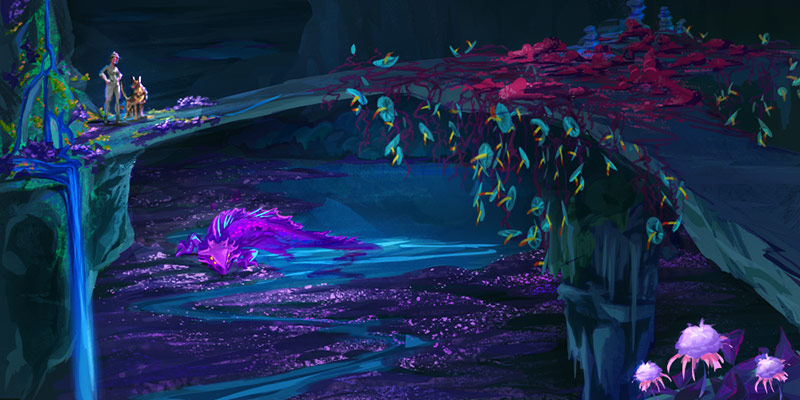
There was no way down.
I had scanned the darkness three times. It was a bottomless pit. No route below, no ledges we could drop down to, no escape. The only path out was the same way we came. Through the passage and back into the lake dragon’s cavern.
I gave it about five minutes after the last of the noises faded, and then Bear and I snuck forward to the mouth of the tunnel. We made it just in time to see the lake dragon pull the bug’s corpse under the water. It would be busy for a while. As long as we avoided the shore, we should be safe.
I searched the perimeter of the cave, staying as far from the lake as I could. There were no other tunnels, but there was a path up, along a ledge that climbed fifty feet above the cavern floor. We took it and picked our way onto a natural stone bridge. It brought us across the cavern to a dark fissure in the opposite wall, barely three feet wide. We squeezed through it, and it spat us out into a wide tunnel.
Ahead the passageway gave way to a large natural arch, and through it I could see more ledges and passages, a warren of tunnels, some dark, some marked by bioluminescence. Unlike the banks of the river, studded with jagged rocks, the floor of the tunnel was relatively flat, with ridges of hard stone breaking through here and there like ribs of some buried giant skeleton. Fossilized roots braided through solid rock between the stone ribs. The air smelled sour and acrid.
Next to me, Bear took a few steps to the side and sniffed something. I focused on it. Stalker poop.
“No,” I whispered and tugged the leash.
She came back and looked at me with slight disapproval. Sniffing strange poop was what dogs did, and I was clearly preventing her from fulfilling her duty.
I could see the other signs now: the faint trail leading to the fissure, more feces, stains from urine on the rocks. These tunnels were stalker hunting grounds. They came through here and took the bridge down to the water below, and because the banks of the river was hard to get to, some of them made their way to the lake to drink. The lake dragon nabbed them like a crocodile ambushing wildebeests.
This wasn’t just a cave stuffed with random monsters. This was an ecosystem. The lake dragon was an apex predator; the giant bug was probably a rank below, and the stalkers were mid-tier. There must be prey species somewhere in these tunnels. There was certainly enough vegetation to support small herbivores.
What were the breaches? Nobody could definitively answer that question, and there was a lot of debate about whether they had been artificially made by the invaders or if our enemy somehow plucked a section of existing reality and wedged it between our worlds.
I could see the pale stains on the rocks, where stone had been bleached by generations of stalkers urinating on it. None of this environment looked new. This was an established bionetwork that developed over years, possibly centuries. All of this had to have belonged somewhere, to a different world.
This was the longest I had ever been in a breach and the furthest I had gone into one. Assault teams spent days, sometimes weeks in the breaches, but my normal MO was to get in, find the resources, and get out. I had no idea if all breaches were like this, but if they were, what would happen to this place when the anchor was destroyed? Did this environment disintegrate, or did it simply return to its place of origin?
I almost felt something, a memory or a trace of knowledge, just outside my reach. A kind of amorphous feeling, like trying to remember a dream. I nearly understood it, but it slipped from my grasp and was gone.
Officially there were thirty-two times when a breach collapsed while people were still inside. Sixty percent of those were considered fatal events – nobody made it out. In the rest of the cases, some people were jettisoned back to the point of the gate’s origin. A large percentage of those survivors showed brain damage with retrograde amnesia. Some had to relearn basic skills like writing and holding a spoon.
Sooner or later, Cold Chaos would put another assault team into this breach. I had to get out before they shattered the anchor.
Bear growled softly.
I flexed. Four shapes were closing in on us, sneaking through the gloom. My talent grasped them, and knowledge came flooding in. The re-nah. Fast, deadly, able to regurgitate acidic bile that would burn exposed skin on contact. Pack hunters, cautious alone, brazen in large numbers. The strongest of the group would attack first, drawing attention, while the rest would flank the prey. Their hearts, on the right side, were possible to reach with a long narrow blade, but the best target was at the base of their throat, just under their chin. A small organ that functioned like a secondary motor cortex. It made them fast and helped them coordinate their movements when they swarmed, and when damaged or destroyed, it induced partial paralysis.
A memory unfurled. A clearing in a deep alien jungle, stalkers streaming from the caves in the mountain side, forming a massive horde. Eyes glowing, fangs bared, two males fighting, each trying to rip out the other’s throat…
I reached down and released Bear’s leash.
Around us the cave was perfectly silent, except for the faint sound of water dripping somewhere out of sight. The bracer on my wrist flowed into my hand, its metal familiar by now, slightly textured and comfortable, like a favorite kitchen knife I had used for years. I focused on the blade. Long, flat, an inch and a half wide. As much damage as possible in a single thrust. The organ would be hard to hit on a moving target. Still better than a heart, though.
Drip. Drip. Drip.
There were no thoughts anymore. I just stood still and waited.
Drip. Drip.
Almost there. They were crouching along the walls, measuring the distance, shifting forward, paw over paw. One large male, two smaller ones, and a female hugging the left wall.
Drip.
The large male charged. He tore out of the gloom like a cannonball, jaws gaping. There was no time to think. I just reacted. My sword slid into the soft tissue of his neck. The male crashed, its momentum carrying him forward despite his locked limbs. Somehow I dodged, and then Bear was on him. The stalker was twice her weight and almost twice her size, but his legs no longer worked. She ripped into his throat, tearing at the wound I’d made.
The remaining males lunged, one from the left, the other from the right. The right one came high, snarling and loud, while the one on the left silently aimed for my legs. I sliced from right to left, turning as I cut. The sword caught the right stalker across the muzzle, carving a bright gash. The stalker recoiled, but I kept going, cutting as I twisted. The blade caught the stalker on the left, slicing through his flesh. There was almost no resistance. The left stalker yelped and scuttled back on three legs, its front left leg severed clean.
Bear ripped into the left stalker. The right one pivoted and charged toward her. I sprinted, slicing like my life depended on it. The right stalker’s head slid off its shoulders.
Bear and the other stalker were a clump of fur and teeth, rolling on the ground. I flexed, willing the moment to stretch out like a rubber band. It did. The frantic whirlwind of bodies slowed, and I narrowed my sword into a spike, and drove down into the base of the stalker’s neck. It went limp.
Time snapped back. A terrible weight smashed into my back. My knees buckled. Scalding teeth sank into my right shoulder.
Pain tore through me, turning into an ice-cold rage.
I turned the sword into a dagger, bent my elbow, and stabbed the blade straight into the female stalker’s face. She dropped off me, backing away to the fissure. I chased her, blood running down my arm. She made it all the way through the gap before I caught her. She spun to face me and bared her teeth, her nose wet with blood. I bore down on her and kicked as hard as I could. My foot connected with her head. She stumbled back and slid off the stone bridge. For a moment she hung on, digging her claws into the bare rock, but her talons slipped, and she plunged into the river below.
Bear. Shit.
I spun around and sprinted back into the tunnel. The three stalker bodies lay unmoving. Bear sat in the middle. Her shoulder was bloody, and there was a long streak of red across her right side. She panted, her eyes bright, her mouth opened in a happy canine smile, like she just ran around through the surf on some beach and was now waiting for a treat.
She saw me, grabbed the smallest stalker by the paw, and tried to drag it toward me. Hi, I’m Bear and these are my dead stalker friends. Look how fancy.
I dug into my pocket, fished some jerky out, and offered it to her. She took it from my fingers, dropped it to the ground, went back to the stalker, bit it some more, came back, and ate the jerky.
“Good girl, Bear. Best girl.”
We were both bleeding, but we were still alive. Four stalkers! We took down four…
I should be dead. And Bear should’ve been dead with me. It took the assault team a bucket of bullets to stop eight stalkers, and Bear and I killed four. A creature the size of a Great Dane had jumped on my back, and I stayed upright. It should’ve knocked me off my feet.
It wasn’t just the weird hallucination and the unusual precision of my talent. I was changing. Physically changing.
The thought pierced me like a jolt of high-voltage current. The hair on the back of my neck rose.
The year after the divorce had twisted me. I used to like flying. In my head, flying was married to vacation, because flights of my childhood took me to the beach and amusement parks. Suddenly I was terrified to board a plane. The fear was so debilitating, I couldn’t even talk while boarding. I became obsessed with traffic, avoiding driving whenever I could. I developed a fixation on my health that bloomed into hypochondria.
I ended up in therapy, where we got to the root of the problem. I had realized that Roger was truly, completely gone and if something happened to me, the kids would be alone. I was desperately trying to exert control over my environment, and when I failed, my body locked up and refused to respond. It took years to get over it, and the hypochondria was the hardest to defeat. Every time I thought I’d finally broken free, it would come back with a vengeance over some minor thing like a new mole or some weird pain in my arm.
In a way, becoming an assessor was the best thing for me. Facing death every week didn’t leave room for anxiety. I was too busy surviving.
In this moment, it was like all those years of therapy, exercise, and rewiring my brain’s responses never happened. Was I dying? Was that glowing thing eating at me like cancer? No doctor would be able to get it out of me. There was no treatment for whatever the fuck it was. What if I wasn’t human anymore? What if I got back to the gate and it wouldn’t let me exit back to Earth?
The grip of anxiety crushed me. I couldn’t talk, I couldn’t move, I just stood there, desperately cataloging everything happening in my body. My breathing, my aches and pains, the strange electric prickling feeling in my fingers. I could hear my own heartbeat. It was fast and so loud…
A cold nose nudged my hand.
I still couldn’t move.
Bear pushed her muzzle into my fingers, bumping me. I felt her fur slide against my hand.
Bump. Bump.
I exhaled slowly. The air escaped out of me, as if it had been trapped in my lungs. I swallowed, crouched, and hugged Bear. Gradually the sound of my heart receded.
Yes, I was changing. No, I had no control over it and I didn’t know what I would become at the end of this process. But I was getting stronger. There were four stalker corpses on this cave floor. I made that happen.
I petted Bear, straightened, walked over to the nearest furry body, and flexed. One hundred and fifty-seven pounds. I grabbed the stalker by the front paws and lifted it off the ground. My shoulder whined in protest. I clenched my teeth against the pain.
I was holding one hundred and fifty-seven pounds of dead weight. It wasn’t resting on my back, no, I was holding it in front of me.
I wonder…
I spun around and threw the corpse. The stalker flew and landed on the cave floor. My shoulder screeched, and I grabbed at it. Okay, not the brightest moment.
The stalker corpse lay 10 feet away. I threw one hundred and fifty-seven pounds across ten feet. Two weeks ago, I’d used a forty-five-pound plate for some overhead squats at the DDC gym, because someone was hogging the Smith machine, and I had a hard time holding it steady for 10 reps.
“We’re not in Kansas anymore, Bear.”
Bear looked at me, padded over to the corpse I threw, and bit it.
“No worries. It’s dead. You are the best girl, Bear, you know that?”
Somewhere in the tangle of the tunnels a creature howled. We couldn’t stay here. We had to keep moving.
I pulled the antibacterial gel out, slathered some on my bleeding shoulder, popped 4 Motrins, and turned to Bear.
“Okay, girl, let’s treat your battle wounds.”
The post The Inheritance: Chapter 5 Part 2 first appeared on ILONA ANDREWS.
Spotlight on “Making History” in Paperback by Richard Cohen
Making History is an exploration of who gets to record the world’s history—from Julius Caesar…
The post Spotlight on “Making History” in Paperback by Richard Cohen appeared first on LitStack.
Monday Meows
Please to be joining my peer network.
Hokay, peering.
I am the slightly alarmed peer.
Hey, alarmed is my gig!
I never really liked peers. I’m more of an apples guy.
A (Black) Gat in the Hand: Weird Tales Rings in Conan
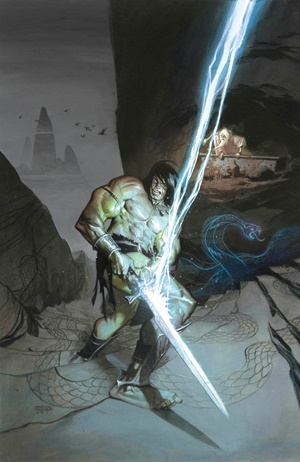 “You’re the second guy I’ve met within hours who seems to think a gat in the hand means a world by the tail.” – Phillip Marlowe in Raymond Chandler’s The Big Sleep
“You’re the second guy I’ve met within hours who seems to think a gat in the hand means a world by the tail.” – Phillip Marlowe in Raymond Chandler’s The Big Sleep
(Gat — Prohibition Era term for a gun. Shortened version of Gatling Gun)
Back in 2018, I started A (Black) Gat in the Hand because I wanted to share my love of hardboiled Pulp. I’ve had some friends join in, and they’ve added some non-hardboiled Pulp, while I’ve expanded my coverage. I’m currently working on my third Kirby O’Donnell essay, and my first on Harold Lamb, which takes us to the Adventure Pulps. And I’m starting another Robert E. Howard Weird Menace post, looking at his occult investigators, Conrad and Kirowan.
One of those stories has a direct link to Conan! A key part of that one is The Ring of Thoth Amon. And if you like the mighty-thewed Cimmerian, you know that ring is integral to the very first Conan tale, “The Phoenix on the Sword.”
Two years before I kicked off my Pulp series under the first title of With A (Black) Gat, I wrote one of the very first essays for Hither Came Conan. Six years ago now, I ruminated on “The Phoenix on the Sword.” I like that story quite a bit. So, we’re bringing that post back for the Summer Pulp series, while I work on the second life of The Ring of Thoth Amon.
I’m pretty sure “Phoenix” was the first Conan story I read. Now, it might have been “The Thing in the Crypt,” in the first Lancer/Ace collection, which I had bought and then stuck on a shelf for at least a decade or two. But I didn’t remember that story when I started going through the Ace books, AFTER exploring Conan via the Del Rey trilogy. So, I think it was “Phoenix.”
The Phoenix on the Sword
It is well known that “The Phoenix on the Sword,” the first story of Conan the Cimmerian, was a rewrite of a previously unsold tale of an earlier Howard character, Kull, an exile from Atlantis.
Howard sold three Kull stories to Weird Tales, appearing in the August and September issues of 1929, and finally, in November of 1930. Howard also wrote nine more tales about the character, which were not published until after his death. So, only 25% of his Kull stories sold. Not exactly a money-maker.
However, “By This Axe I Rule!”, which had failed to sell to Argosy and Adventure, was dusted off to feature a less-philosophical barbarian.
I struggled through the Kull Canon. I definitely prefer Conan, Solomon Kane, and El Borak. The Kull stories seem, to me, to be overly philosophical and full of metaphysical meanderings. “The Mirrors of Tuzun Thune,” which actually appeared in Weird Tales, is one of my least favorite of Howard’s published work. Kull stares in mirrors all day, waxing thoughtful. It’s mind-numbingly dull.
SPOILER ALERT – You absolutely should already have read the original REH story, before reading this essay. Reading on before reading Howard’s “The Phoenix on the Sword” makes no sense at all. You’re definitely gonna ruin the story. END OF SPOILER ALERT.
The heart of “Axe!” and “Phoenix” is the same. A barbarian has taken the kingship of a civilized nation by the sword. He is hailed as a liberator at first, but his status as an outsider and a savage undermines his rule. A coalition of malcontents, led by one Ascalante, plots to assassinate him in his rooms at night: both stories include a banished former noble now outlaw; a useless noble with a faint trace of royal blood in his veins; a dwarf noble with waning influence and declining wealth; an ambitious military commander; and a fool-headed minstrel. That part of the story is all but the same, even to a bribed officer of the guard leading away the royal bodyguard and disappearing forever (smart guy).
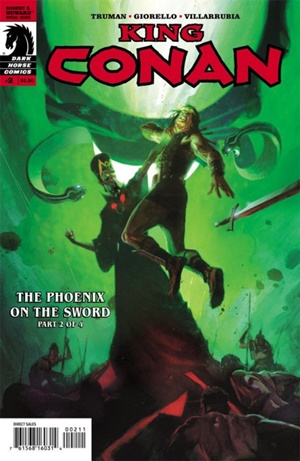 The fight, when the conspirators, with 16 nameless rogues to help, invade the royal bedchamber, is pretty much the same in both stories. Well, to a point…
The fight, when the conspirators, with 16 nameless rogues to help, invade the royal bedchamber, is pretty much the same in both stories. Well, to a point…
Where the “Phoenix” varies is that, in replacing Kull with Conan, Howard makes it a sword and sorcery story. The subplot in “By This Axe I Rule!” involves a young noble, Seno val Dor, who wants to marry Ala, a slave girl. However, such a union is forbidden by Valusian law. And law is inviolate. Even the king is helpless to change it. Seno and Ala cannot wed.
Kull fights off the almost two-dozen invaders, until only Ascalante remains. The rebel has the advantage, until Seno arrives and slays the would-be assassin with a thrown dagger. Ala had overheard the plot and gone to her beloved, who gathered up his men and rushed to the king’s aid.
Kull, wounded and weak, orders the tablet regarding the law of slaves to be brought to him. Once that’s done, he lets his thoughts be known:
“Hear you! I am weary of this business! I am no king but a slave! I am hemmed in by laws, laws, laws! I cannot punish malefactors nor reward my friends because of law – custom – tradition! By Valka, I will be king in fact as well as name!”
He declares that Seno and Ala saved his life, and they may marry. This does not go over well with the traditionalists, as you can well imagine. The king is… unperturbed.
‘”I am the law!” roared Kull, swinging up his axe; it flashed downward and the stone tablet flew into a hundred pieces. The people clenched their hands in horror, waiting dumbly for the sky to fall.’
Thinking outside the box was not exactly encouraged in Valusia.
The speech continues as Kull drives his point home, tossing aside the royal scepter and brandishing the bloody axe. At the end of the story, it’s clear he will rule, enforcing those laws he declares just and discarding those he does not. It certainly seems like the blueprint for an unchallenged despot.
It’s actually a decent enough read and not a bad story.
But for “The Phoenix on the Sword,” Howard completely tosses out the noble-slave love story and the discourse on the suffocating effects of unalterable law. Instead, he brings in the fantastic, making it a sword and sorcery tale.
Now, Conan does wax eloquent on the duties of kingship, just as Kull did. This:
“The trouble with me, Brule – I did not dream far enough. I always visualized merely seizing the throne -I did not look beyond. When King Borna lay dead beneath my feet, and I tore the crown from his gory head, I had reached the ultimate border of my dreams. From there, it has been a maze of illusions and mistakes. I prepared myself to seize the throne – not to hold it.”
Became this:
“I did not dream far enough, Prospero. When King Numedides lay dead at my feet and I tore the crown from his gory head and set it on my own, I had reached the ultimate border of my dreams. I had prepared myself to take the crown, not to hold it. In the old days all I wanted was a sharp sword and a straight path to my enemies. Now the path is straight and my sword is useless.”
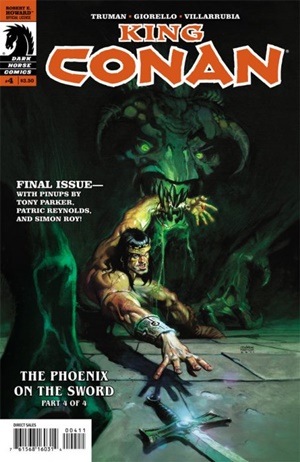 Pretty much the same thing. Though, the writing is a little bit better in the second version. Howard continually honed his skill.
Pretty much the same thing. Though, the writing is a little bit better in the second version. Howard continually honed his skill.
But while the focus of the remainder of the Kull story is instead of fretting over his limitations as king, Howard has Conan dream.
Now, this little dream interlude matters, because Ascalante has a slave named Thoth-Amon. A Stygian, he was once a powerful sorcerer, but he had lost his magical Ring of Set, and was now weak, and in hiding. He is sent to accompany Dion, the totally useless noble, to make sure that the latter doesn’t expose the plot. Dion, who is beyond clueless, has the very ring Thoth Amon seeks. Quickly reclaiming it with a dagger, the sorcerer turns to revenge against Ascalante, using his once-lost dark arts. Unfortunately for Conan, he’s only a few feet away from the potential royal usurper. He’s definitely in the neighborhood of being collateral damage.
Howard was the best prose writer I’ve discovered yet in the fantasy field. He just had a fantastic way with words:
“There was a movement about him, such a swirl as is made in water when some creature rises to the surface. A nameless, freezing wind blew on him briefly, as if from an opened Door. Thoth felt a presence at his back, but he did not look about. He kept his eyes fixed on the moonlit space of marble, on which a tenuous shadow hovered. As he continued his whispered incantations, this shadow grew in size and clarity, until it stood out distinct and horrific. Its outline was not unlike that of a gigantic baboon, but no such baboon ever walked the earth, not even in Stygia. Still, Thoth did not look, but drawing from his gridle, a sandal of his master – always carried in the dim hope that he might be able to put it to such use – he cast it behind him.”
From Thoth Amon staring at the ring he has longed for, through the beast passing by a stunned guard at the palace (which ends chapter three), this is a terrific sequence of writing.
Meanwhile, asleep in his chamber, Conan travels to a magnificent tomb. There he meets the long-dead sage, Epemitrius, who, during his life, fiercely battled the evil snake-god, Set. Epemitrius etches the symbol of a phoenix onto Conan’s sword. Then, Conan wakes in his room and hears stealthy footsteps in the corridor and begins to prepare himself for combat.
The battle scene is similar in both versions, with Kull and Conan trying to avoid harming the mad minstrel (I found that whole ‘a minstrel is greater than a king’ something more fitting for de Camp and Carter than Howard, myself).
With all the rogues either dead or fled (hey, that rhymed!), Ascalante gains the advantage and is about to kill Kull in the original version. Only to have Sena save the day. But there is no Sena and Ala in Conan’s version. And while I think it has been good up to this point, it is here that “The Phoenix on the Sword” really shines and we see Robert E. Howard’s emergence as one of the greatest fantasy writers.
Conan uses his axe-arm to wipe blood from his eyes at precisely the wrong moment. Ascalante, alone and with nothing to lose, rushes at him. The would-be assassin doesn’t quite make it there:
“But even as he began his charge, there was a strange rushing in the air and a heavy weight struck terrifically between his shoulders. He was dashed headlong and great talons sang agonizingly in his flesh. Writhing desperately beneath his attacker, he twisted his head about and started into the face of Nightmare and lunacy. Upon him crouched a great black thing which he knee was born in no sane or human world. Its slavering black fangs were near his throat and the glare of its yellow eyes shriveled his limbs as a killing wind shrivels young corn. The hideousness of its face transcended mere bestiality.”
“In those abhorrent features the outlaw’s dilated eyes seemed to see, like a shadow in the madness that enveloped him, a faint and terrible resemblance to the slave Thoth-Amon.”
I mean, WOW!!! (Yeah, I know. My keen analysis is breathtaking…)
Ascaltante dies of sheer terror: “Then, Ascalante’s cynical and all-sufficient philosophy deserted him, and with a ghastly cry he gave up the ghost before those slavering fangs touched him.”
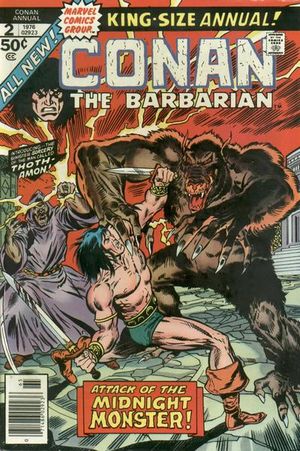 Howard had developed Ascalante in this short story. He is not just a paper-thin supporting character. And he did a fantastic job of having the man, in the absolute horror of his final moments, get at least a flickering understanding that his slave had gotten his revenge. And then, he dies. It’s brilliant work.
Howard had developed Ascalante in this short story. He is not just a paper-thin supporting character. And he did a fantastic job of having the man, in the absolute horror of his final moments, get at least a flickering understanding that his slave had gotten his revenge. And then, he dies. It’s brilliant work.
Which leaves a ‘frozen’ Conan to face this new threat. And in just THREE paragraphs, Howard gives us a marvelous fight between the Cimmerian and the supernatural creature. At this point, I think that “Phoenix” is simply a much more interesting and entertaining story than “Axe!” was.
The creature would have killed Conan, if not for the phoenix etched on his sword by Epimetrius. That allowed the weapon, even though broken earlier in the fight, to fatally wound it.
I think that “By This Axe I Rule!” Is a good enough story. Though, it’s not one I would turn back to very often. Whereas, I’ve re-read “The Phoenix on the Sword” quite a few times. In large part, because I like the swords and sorcery aspect of it.
Thoth Amon was the catalyst, though not actually present, in “The God in the Bowl.” So, Howard had him in mind for two of the first three Conan tales. But he never again used the Stygian sorcerer. And since “Bowl” was rejected by Wright and not published until 1952, he was effectively a one-shot character in the authentic Conan Canon.
That changed, however, when L. Sprague de Camp decided to make him the main antagonist in the barbarian’s life, as he laid out the original and ‘new’ tales as a Conan Saga. The Marvel comics also utilized Thoth Amon, so that he is now generally considered ‘the’ Conan villain.
While it’s not the best Conan story written by Howard, I do think it’s the perfect introduction to Conan. He already has many exploits behind him and is now a king. It’s got a royal assassination plot: and sorcery. And it has the quality writing characteristic of much of Howard’s work.
2025 (3)
Shelfie – Dashiell Hammett
Windy City Pulp & Paper Fest – 2025
Will Murray on Who was N.V. Romero?
2024 Series (11)
Will Murray on Dashiell Hammett’s Elusive Glass Key
Ya Gotta Ask – Reprise
Rex Stout’s “The Mother of Invention”
Dime Detective, August, 1941
John D. MacDonald’s “Ring Around the Readhead”
Harboiled Manila – Raoul Whitfield’s Jo Gar
7 Upcoming A (Black) Gat in the Hand Attractions
Paul Cain’s Fast One (my intro)
Dashiell Hammett – The Girl with the Silver Eyes (my intro)
Richard Demming’s Manville Moon
More Thrilling Adventures from REH
Prior Posts in A (Black) Gat in the Hand – 2023 Series (15)
Back Down those Mean Streets in 2023
Will Murray on Hammett Didn’t Write “The Diamond Wager”
Dashiell Hammett – ZigZags of Treachery (my intro)
Ten Pulp Things I Think I Think
Evan Lewis on Cleve Adams
T,T, Flynn’s Mike & Trixie (The ‘Lost Intro’)
John Bullard on REH’s Rough and Ready Clowns of the West – Part I (Breckenridge Elkins)
John Bullard on REH’s Rough and Ready Clowns of the West – Part II
William Patrick Murray on Supernatural Westerns, and Crossing Genres
Erle Stanley Gardner’s ‘Getting Away With Murder (And ‘A Black (Gat)’ turns 100!)
James Reasoner on Robert E. Howard’s Trail Towns of the old West
Frank Schildiner on Solomon Kane
Paul Bishop on The Fists of Robert E. Howard
John Lawrence’s Cass Blue
Dave Hardy on REH’s El Borak
Prior posts in A (Black) Gat in the Hand – 2022 Series (16)
 Asimov – Sci Fi Meets the Police Procedural
Asimov – Sci Fi Meets the Police Procedural
The Adventures of Christopher London
Weird Menace from Robert E. Howard
Spicy Adventures from Robert E. Howard
Thrilling Adventures from Robert E. Howard
Norbert Davis’ “The Gin Monkey”
Tracer Bullet
Shovel’s Painful Predicament
Back Porch Pulp #1
Wally Conger on ‘The Hollywood Troubleshooter Saga’
Arsenic and Old Lace
David Dodge
Glen Cook’s Garrett, PI
John Leslie’s Key West Private Eye
Back Porch Pulp #2
Norbert Davis’ Max Latin
Prior posts in A (Black) Gat in the Hand – 2021 Series (7 )
The Forgotten Black Masker – Norbert Davis
Appaloosa
A (Black) Gat in the Hand is Back!
Black Mask – March, 1932
Three Gun Terry Mack & Carroll John Daly
Bounty Hunters & Bail Bondsmen
Norbert Davis in Black Mask – Volume 1
Prior posts in A (Black) Gat in the Hand – 2020 Series (21)
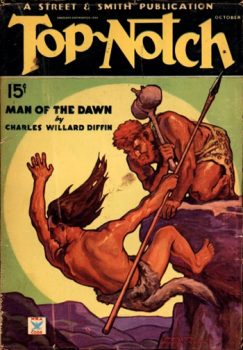 Hardboiled May on TCM
Hardboiled May on TCM
Some Hardboiled streaming options
Johnny O’Clock (Dick Powell)
Hardboiled June on TCM
Bullets or Ballots (Humphrey Bogart)
Phililp Marlowe – Private Eye (Powers Boothe)
Cool and Lam
All Through the Night (Bogart)
Dick Powell as Yours Truly, Johnny Dollar
Hardboiled July on TCM
YTJD – The Emily Braddock Matter (John Lund)
Richard Diamond – The Betty Moran Case (Dick Powell)
Bold Venture (Bogart & Bacall)
Hardboiled August on TCM
Norbert Davis – ‘Have one on the House’
with Steven H Silver: C.M. Kornbluth’s Pulp
Norbert Davis – ‘Don’t You Cry for Me’
Talking About Philip Marlowe
Steven H Silver Asks you to Name This Movie
Cajun Hardboiled – Dave Robicheaux
More Cool & Lam from Hard Case Crime
A (Black) Gat in the Hand – 2019 Series (15)
Back Deck Pulp Returns
A (Black) Gat in the Hand Returns
Will Murray on Doc Savage
Hugh B. Cave’s Peter Kane
Paul Bishop on Lance Spearman
A Man Called Spade
Hard Boiled Holmes
Duane Spurlock on T.T. Flynn
Andrew Salmon on Montreal Noir
Frank Schildiner on The Bad Guys of Pulp
Steve Scott on John D. MacDonald’s ‘Park Falkner’
William Patrick Murray on The Spider
John D. MacDonald & Mickey Spillane
Norbert Davis goes West(ern)
Bill Crider on The Brass Cupcake
A (Black) Gat in the Hand – 2018 Series (32)
George Harmon Coxe
Raoul Whitfield
Some Hard Boiled Anthologies
Frederick Nebel’s Donahue
Thomas Walsh
Black Mask – January, 1935
Norbert Davis’ Ben Shaley
D.L. Champion’s Rex Sackler
Dime Detective – August, 1939
Back Deck Pulp #1
W.T. Ballard’s Bill Lennox
Erle Stanley Gardner’s The Phantom Crook (Ed Jenkins)
Day Keene
Black Mask – October, 1933
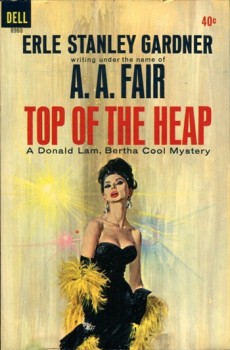 Back Deck Pulp #2
Back Deck Pulp #2
Black Mask – Spring, 2017
Erle Stanley Gardner’s ‘The Shrieking Skeleton’
Frank Schildiner’s ‘Max Allen Collins & The Hard Boiled Hero’
A (Black) Gat in the Hand: William Campbell Gault
A (Black) Gat in the Hand: More Cool & Lam From Hard Case Crime
MORE Cool & Lam!!!!
Thomas Parker’s ‘They Shoot Horses, Don’t They?’
Joe Bonadonna’s ‘Hardboiled Film Noir’ (Part One)
Joe Bonadonna’s ‘Hardboiled Film Noir’ (Part Two)
William Patrick Maynard’s ‘The Yellow Peril’
Andrew P Salmon’s ‘Frederick C. Davis’
Rory Gallagher’s ‘Continental Op’
Back Deck Pulp #3
Back Deck Pulp #4
Back Deck Pulp #5
Joe ‘Cap’ Shaw on Writing
Back Deck Pulp #6
The Black Mask Dinner

Bob Byrne’s ‘A (Black) Gat in the Hand’ made its Black Gate debut in 2018 and has returned every summer since.
His ‘The Public Life of Sherlock Holmes’ column ran every Monday morning at Black Gate from March, 2014 through March, 2017. And he irregularly posts on Rex Stout’s gargantuan detective in ‘Nero Wolfe’s Brownstone.’ He is a member of the Praed Street Irregulars, founded www.SolarPons.com (the only website dedicated to the ‘Sherlock Holmes of Praed Street’).
He organized Black Gate’s award-nominated ‘Discovering Robert E. Howard’ series, as well as the award-winning ‘Hither Came Conan’ series. Which is now part of THE Definitive guide to Conan. He also organized 2023’s ‘Talking Tolkien.’
He has contributed stories to The MX Book of New Sherlock Holmes Stories — Parts III, IV, V, VI, XXI, and XXXIII.
He has written introductions for Steeger Books, and appeared in several magazines, including Black Mask, Sherlock Holmes Mystery Magazine, The Strand Magazine, and Sherlock Magazine.
You can definitely ‘experience the Bobness’ at Jason Waltz’s ’24? in 42′ podcast.
Book Review: Shield of Sparrows by Devney Perry
I received a review copy from the publisher. This does not affect the contents of my review and all opinions are my own.
 Shield of Sparrows by Devney Perry
Shield of Sparrows by Devney Perry
Mogsy’s Rating: 4 of 5 stars
Genre: Romance, Fantasy
Series: Book 1
Publisher: Red Tower Books (May 6, 2025)
Length: 528 pages
Author Information: Website | Twitter
The romantasy genre is more crowded than ever these days, so whenever one stands out, I tend to take notice! While a novel like Shield of Sparrows by Devney Perry may follow a familiar blueprint, it manages to execute it with enough style and panache to feel instantly recognizable but not stale. To my delight, I had a great time with it.
The book follows Princess Odessa, the eldest daughter of the king of Quentis who has spent most of her life in the shadow of her younger half-sister. After all, it is Mae who is the favored child, the one promised to the prince of neighboring Turah, and the one carefully trained to become a spy and uncover the rival kingdom’s deepest secrets. However, when the time finally comes to seal the alliance through marriage, the Turan prince Zavier unexpectedly invokes an ancient rite that allows him to choose Odessa as his bride instead, much to everyone’s surprise.
And thus, with little warning, our protagonist is shipped off to a foreign land alongside her new husband and his loyal soldier, known only as the Guardian. Tasked with furthering her father’s political agenda, Odessa must quickly learn to navigate the unfamiliar ways of the Turan court if she is to one day become their queen, except this is proving far more difficult and treacherous than she ever imagined. While Prince Zavier remains distant and tightlipped about the problems plaguing his kingdom, monsters stalk the wilds and prey on his people, and a mysterious illness spreading across Turah is corrupting everything it touches. At the heart of it all stands the enigmatic Guardian, bound to protect the royal couple yet is shrouded in secrets of his own. Although his insufferable personality constantly frustrates Odessa, it appears that their paths—and perhaps even their destinies—may be inextricably linked.
Through all of this, the main character’s journey gives readers a fast-paced entry into the fantasy world of Shield of Sparrows. Rather than packing her prose with exposition, Perry lets us explore the magic of it on our own, discovering a wondrous landscape featuring mythical beasts and layers of rich history. While the slow trickle of information can sometimes make you feel impatient, the steady ramp up is well worth it in the end as it leads to a result that is both epic and cinematic.
But of course, what everyone wants to know is, how is the romance? I have to say, the character work is where this novel is strongest. First, we have Odessa, a heroine who is initially perceived as unassuming and weak, but her growth over the course of the story is realistic and tangible. Similarly, the book’s romantic arc, which ultimately ends up being between her and the Guardian, is very well written and deliciously paced—no frivolous claims of being slow-burn in the publisher description only to end up being insta-love, thank goodness. Their love story is one that unfolds through sharp dialogue and moments of mutual vulnerability, but the drama never feels intrusive, nor does it ever overwhelm the conflicts that drive the main plot. Sure, there’s still plenty of manufactured angst stemming from dumb reasons like miscommunication and the deliberate withholding of truth, but at least we got a few genuine twists and surprises out of it.
That said, in terms of storytelling, Shield of Sparrows is in no way reinventing the wheel. Still, there are sufficient emotional beats to keep things entertaining and fresh, with thrills frequently injected in the form of monster attacks and court intrigue. Plus, Odessa’s unique experiences in Turah alone are enough to give this story its staying power, not to mention the evolving relationships she builds along the way. Admittedly, the pacing could have used some tweaking, particularly the middle section where the plot meandered and momentum faltered, or the ending where things went the other direction and became pure pandemonium in an instant. Ultimately though, these are relatively minor quibbles.
In short, Shield of Sparrows might not break new romantasy ground, but it doesn’t have to. Genre fans will be happy that it hits all the right notes and provides plenty of reasons to crave the next book. The ending left me reeling, and after all that chaos, I’m going to need some answers.
![]()
![]()
A Challenge Worth Smiling About: Tim Waggoner on Writing Conan

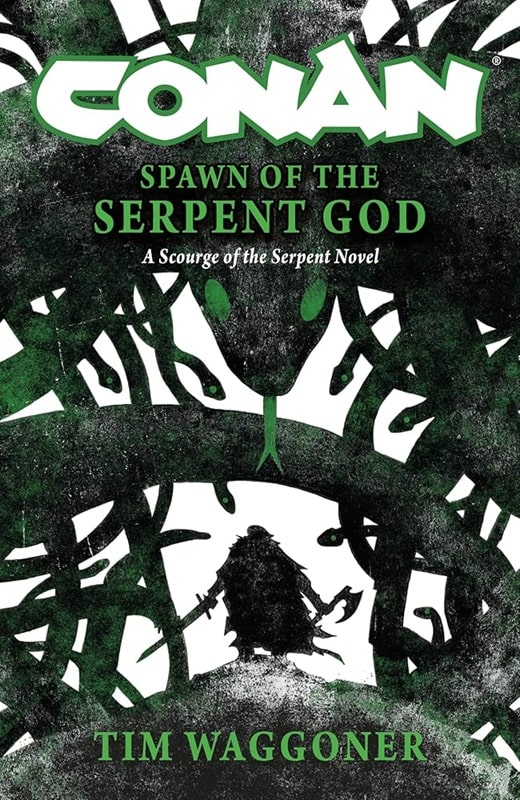
Tim Waggoner, and his upcoming novel Conan: Spawn of the Serpent God (Titan Books, October 28, 2025)
On a non-descript day I am intercepted on entering a coffee shop. It turns out to be a happy accident, an old colleague, eager to join me as I wait for my next interview to begin. The distraction is welcome but doesn’t help much. My interviewee isn’t late but they aren’t early either and I’m beginning to get nervous.
“You’re waiting for him, aren’t you?” the friend asks.
Neither of us mentioned his name because we didn’t have to. Some things, in certain contexts, go together like cheese and tortillas. With four Stoker Awards and many great novels to his name, Tim Waggoner has developed that kind of reputation in this part of Ohio. If Massachusetts is Lovecraft Country then downtown Dayton is Waggonerstan.
[Click the images for Conan-sized versions.]
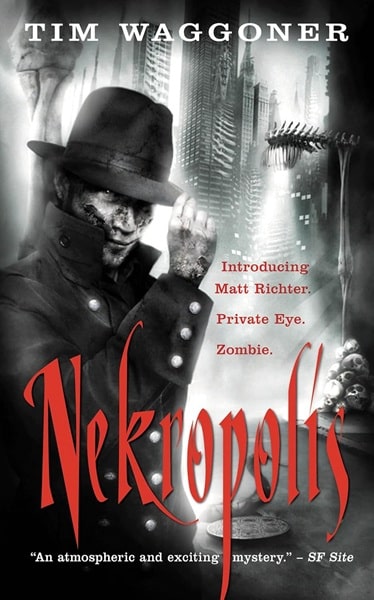
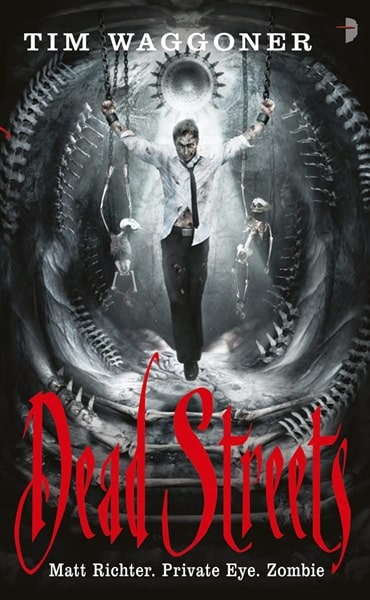
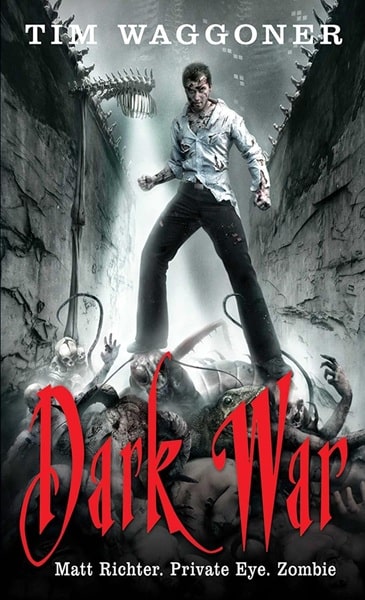
The Nekropolis series by Tim Waggoner: Nekropolis, Dead Streets, and
Dark War (Angry Robot, 2009, 2010, and 2011). Covers by Vincent Chong
“What’s the interview about?”
I swerve the question because this former colleague is a journalist too. When it comes to what Waggoner has to say about the novel we’ve come to talk about, I’d rather get it in Black Gate first. A book the author later estimates is the 62nd or 63rd of his career.
That brief period of forbearance is soon rewarded when Waggoner arrives. I can tell he’s been busy cooking up something special with his new novel. It does not take long before coffee and talk of Conan begins to flow.
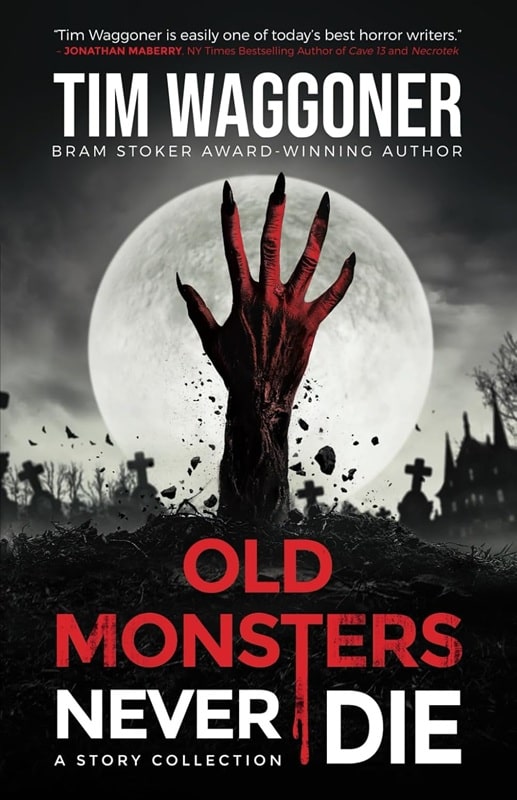
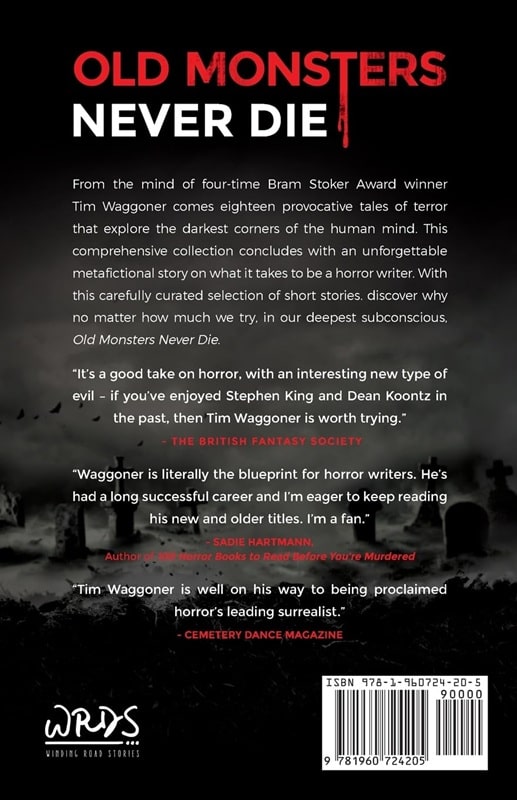
Old Monsters Never Die: A Story Collection by Tim Waggoner
(Winding Road Stories, May 24, 2024). Cover art uncredited
Anyone familiar with Waggoner’s literary career knows he’s worn many hats over the years, dipping his proverbial toe in one genre or another. There’s the Nekropolis series, the fantasy Blade of the Flame novels, and award-winning books on the craft of writing such as Writing in the Dark. Even among those massive projects, trilogies, and the travails every writer faces, working on a Conan novel was a special challenge. In fact, that’s exactly why the first time opportunity came knocking he said no.
“My agent told me Titan was doing Conan and asked if I was interested. I just thought there was no way I could do it because it’s not just about Conan but also the world he inhabited. It’s a very realized world with multiple countries. I just didn’t know if I could do it. After saying no the first time, when I was asked again I just had to do it. I said yes and immersed myself in all the Conan stories I could,” Waggoner told me.
That meant diving deep into the lore of the famous barbarian, going back to the original stories and working his way up to Titan’s ongoing series. It’s clear, however, that like many fantasy fans Waggoner was not coming to Conan blind. This certainly wasn’t his first time in the Hyborian Age.
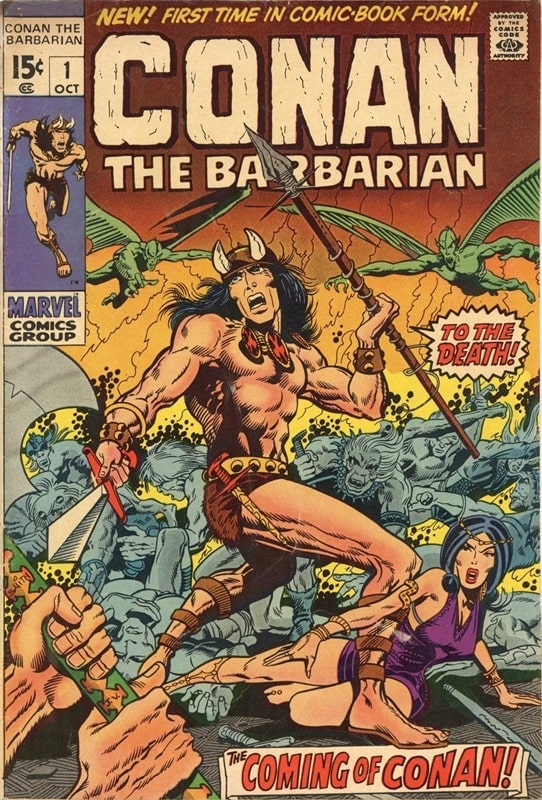

Marvel Comics Conan the Barbarian, issue #1 (Marvel Comics, October, 1970). Cover by Barry Windsor-Smith
“Most of my experience with Conan had been with the comics. As a kid I knew him mostly through Marvel Comics. I had the very first issue for years and wish I’d kept it. I don’t know what happened to it. Probably fell apart I read it so often.”
Through cultural osmosis he learned more about the character through films and other comics. But going back to the original well of creativity that spawned one of fantasy’s greatest protagonists taught him a lot that would serve him well during the writing process. He listened to them on audiobook and read them at home. Waggoner also went on to read the King Kull stories, El Borak, and even Solomon Kane. But it was the stories about Conan that were most integral.
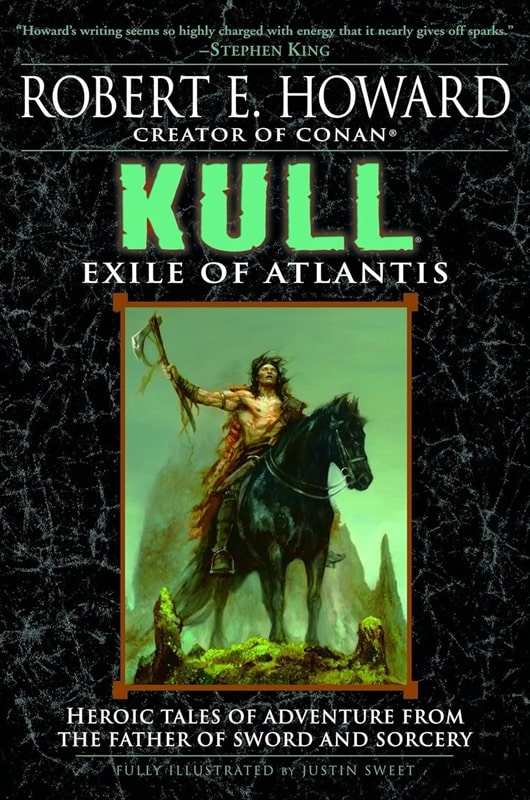
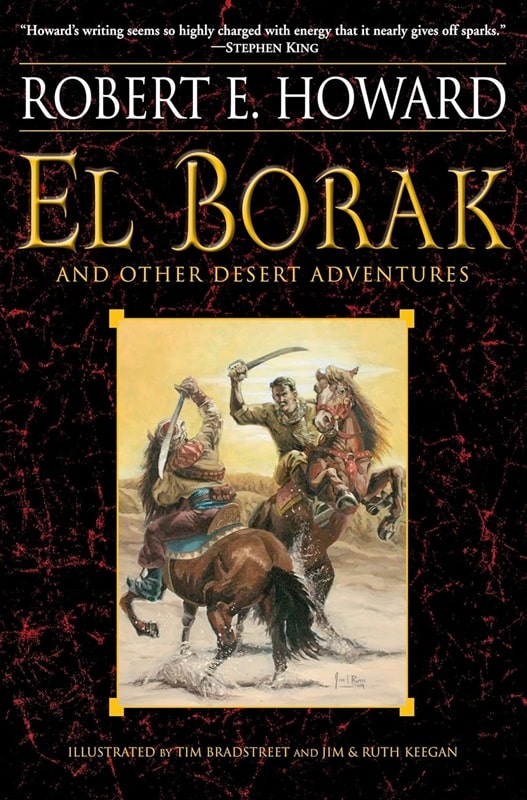
Two Del Rey Robert E. Howard volumes: Kull: Exile of Atlantis, and El Borak and Other Desert
Adventures. (October 31, 2006, and February 9, 2010). Covers by Justin Sweet, and Jim & Ruth Keegan
“It really helped me because the one thing I didn’t get in the comics or in the movies is how much a part of the story the setting is,” he said. “It took me forever to get started on it. I couldn’t figure out where to start but eventually it clicked overall. But a big part of it was realizing the setting was a big part of the story.”
Writing the book was an experience Waggoner described as ‘intimidating’. Who can blame him? Even with decades of experience, taking on a character with such a rich history and fans spanning the globe would challenge anyone.
“I had to try and think of what my version of Conan was because no matter what I knew I wouldn’t be able to write his,” said Waggoner in reference to Howard. “Part of what I did is work that out on the page. Here’s this guy who will critique civilization even as he is drawn to it. I asked myself, ‘why does he do that?’”
One aspect of Conan that fascinated Waggoner is his evolution over time, from thief to pirate to mercenary and eventually king. As the author explains, Cimmerians generally don’t travel outside Cimmeria. Finding out where that thirst for adventure came from was integral to understanding the character.

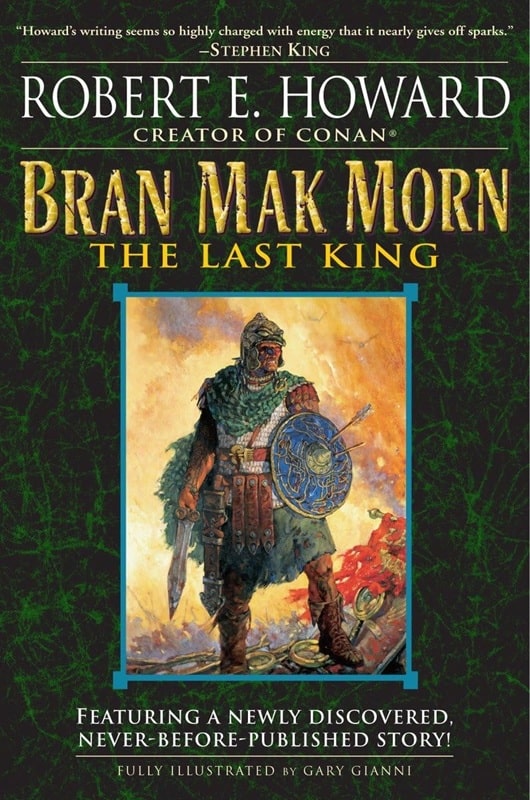
Two more Del Rey Howards: The Savage Tales of Solomon Kane and
Bran Mak Morn: The Last King (July 2004 and June 2005). Covers by Gary Gianni
“I did find out that in a letter Robert E. Howard wrote that Conan’s grandfather had traveled some, told him stories as a kid, and that was of what woke that in him. While he (Howard) never wrote it in a story that helped me see where part of that aspect of Conan came from. But part of that is just his nature too,” Waggoner explained.
The novel, according to Waggoner, will show readers two sides of the barbarian with the story focused on Conan’s life at 17 and 32. It’s a two-part story separated by 15 years, which helped the author show the titular character’s growth over time. This can be seen in his natural cursiotiy as a teenage thief as well as in his expansive knowledge of other languages and cultures later on. Conan’s interactions with religion and the origin of his unique sense of chivalry are also touched on in the book.
“That’s because when I write any kind of tie-in like this I try to imagine them as real people. If I’m trying to write about Conan being real then I have to ask myself why does he do these sorts of things and why are they so important to his character?”
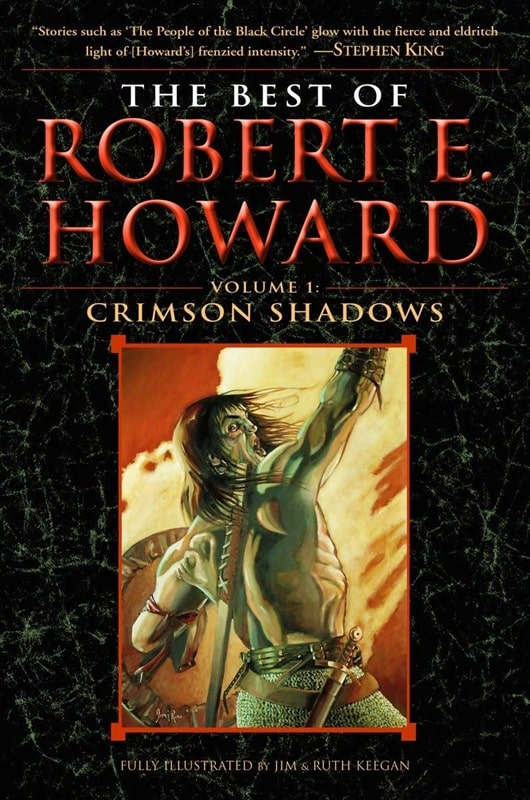

The Best of Robert E. Howard, Volumes 1 & 2: Crimson Shadows and Grim Lands
(Del Rey, August 31, 2009 and December 2007). Covers by Jim Keegan and Ruth Keegan
Its an approach that has worked well in the past and allowed him to touch on a part of Conan a some have missed in the past.
“I think one thing some of the comics and movies miss is that while he (Conan) is dour and grim, that’s not all he is. Howard says in that one description ‘gigantic mirths and gigantic melancholies’. The mirth part you don’t see very much. I tried to put some of that in there. I also tried to show how he had a lot more anger and was quicker to violence at 17 than he was at 32. Over time, he becomes a lot more skilled.”
Of course, given the amount of time left between now and the book’s listed Oct. 27 publication date, things may change and edits might be made. Waggoner admits that some of what he wrote might be edited out though he is hopeful. Midway through the conversation I mention Conan’s connection to Cthulhu and Waggoner’s answer leaves me hopeful too.
“I tried to include some of that too,” he said with a smile.
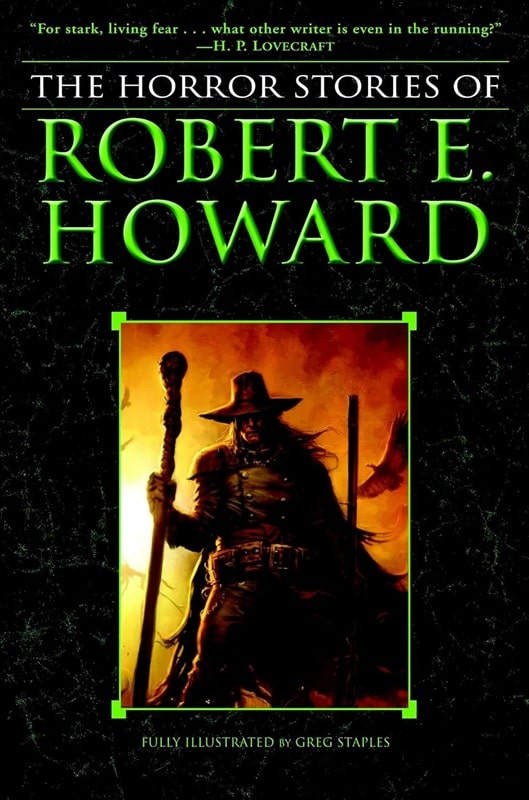
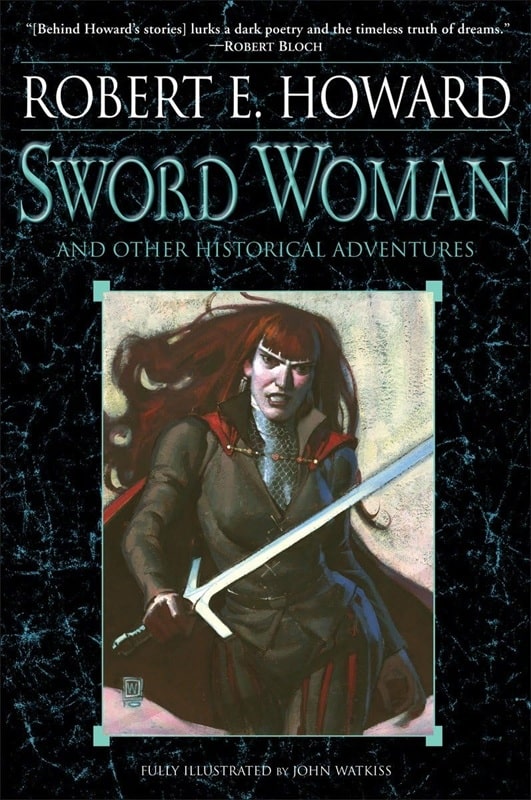
The Horror Stories of Robert E. Howard and Sword Woman (Del Rey,
July 29, 2008 and January 25, 2011). Covers by Greg Staples and John Watkiss
Regardless, its clear a ton of work has gone into making the novel as best as it can be. When Conan: Spawn of the Serpent God does come out, it will be a welcome addition to many bookshelves around the world. And if Titan’s release schedule is anything to go by, the beloved sword-wielding warrior shows no signs of slowing down. Conan, its no exaggeration to say, is thriving.
“I think he’s endured so long because he’s the same sort of character, ultimately, as the lone gunslinger or the private eye. He’s the individual that is true to himself and can be himself in whatever society he’s in,” Waggoner said.
But there is one other ingredient the author feels separates Conan from the pack. One so important it leaves other legacy characters like Sam Spade and The Shadow in the dust.
“With Conan his motive ultimately is adventure. It’s living life and experiencing it absolutely to the fullest. You don’t see that in a lot of warrior type characters. You don’t see that in the lone gunslinger. The private eye is usually depressed. Conan, however, I don’t think we even know what happens to him at the end of his life because eventually he tells his son ’you be king, I’m out of here’ and just goes adventuring all over again,” Waggoner said with a laugh.
Ismail D. Soldan is an author, journalist, and poet. His work has previously appeared in Illustrated Worlds, LatineLit, and The Acentos Review among other publications. A proud explorer of both real and imagined worlds, his most recently published short story can be read in the January 2025 issue of Crimson Quill Quarterly, and his last article for Black Gate was New Adventures for the World’s Favorite Barbarian.
Tubi Dive, Part V
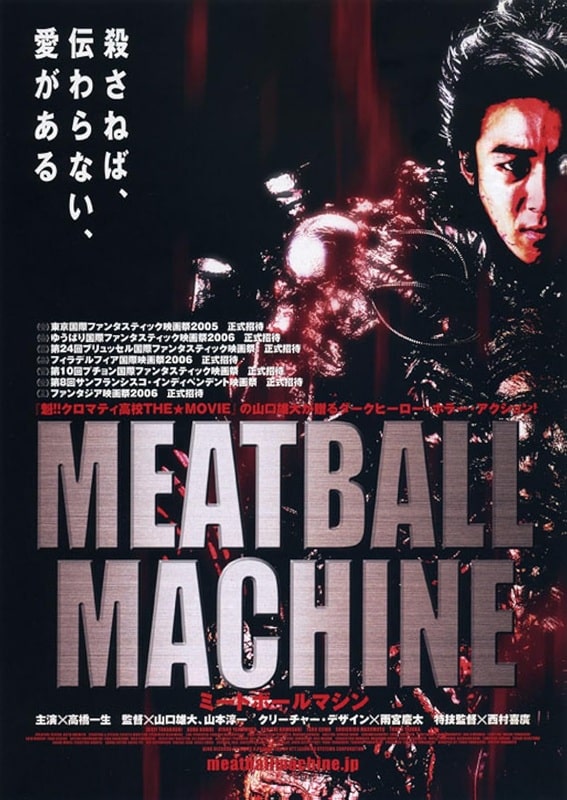

Meatball Machine and Meatball Machine Kodoku (TLA Releasing, 2005 and 2017)
50 films that I dug up on Tubi.
Enjoy!
Meatball Machine (2005) and Meatball Machine Kodoku (2017)It’s a double-header in more ways than one, as I settled down to watch a couple of films that bookend a period known to cinephiles as Gonzo Japanese Splatter. Between these films, we were served up classics such as Tokyo Gore Police, Machine Girl, and the afore-reviewed Toilet of the Dead and Dead Sushi, but those are just the tip of the grue-coated iceberg.
If you are familiar with Tetsuo: The Iron Man from 1989, you’ll already have a grasp of the themes in these films; isolation, sexual desire, transformation, body horror and extreme gore.
Meatball Machine was directed by Yūdai Yamaguchi with effects by long-time Noboru Iguchi collaborator Yoshihiro Nishimura (Nishimura would later go on to direct the Meatball sequel). It looks like it was shot on digital video, with blown out colors, and I’m not a fan, but that could also be down to the dodgy copy Tubi has.
The story concerns Yōji, a downtrodden young man who has a rubbish job and stifles his loneliness by pining for a young woman, Sachiko, whom he watches from afar during his lunch breaks. In the background of this sob story, we learn that parasites are taking over people and mutating them into killing machines, for reasons.
Yōji stumbles across the carapace of one of these creatures and takes it home. One night, after saving Sachiko from a sexual assault, they finally get to sit and talk, and discover they are both lonely. This is all building up to a sweet moment, but then the carapace springs into life, attaching itself to Sachiko and OH MY FREAKING GOD. Yamaguchi cranks everything up to 11 and covers everyone in dripping gore throughout the rest of the film. It’s wild, utterly bonkers, and ridiculously entertaining (if you like that sort of thing, you disgusting person, you). Multiple fights and plot twists ensue, and a new sub-genre is kickstarted into horrific life.
Meatball Machine Kodoku takes the idea in a completely different direction, leaning heavily into an aliens angle while also expanding upon the lore. Director Nishimura, always on the lookout to outdo himself and everyone else in the genre, goes completely potty, coming up with some of the weirdest and most wonderful body transformations I have ever seen.
In this film, Yuji, a downtrodden, middle-aged man who hates his debt collecting job, secretly pines for a cute young woman, Kaoru, who works in his local bookstore. When he saves her from a potential assault, they finally get together and, yes, you guessed it, everything goes to poop. So far, so very similar.
However, this time the parasites infest a whole city, not only that, but they trap the entire city in a giant alien bell jar, and let everyone kill each other. For reasons.
One aspect I enjoyed about this one was that when mutated by a parasite, your body’s weapon is the thing you are most recently connected to. So a construction worker gets a jackhammer for an arm, while a burlesque dancer who was eating spaghetti ends up with a fork. It’s especially fun watching the parasites control their hosts with outlandish levers in their little pod ‘brains.’ This film is actually light on horror for the first 30 minutes, and then BOOM — a chopped off willy and a bisected pair of lovers kick off the whole shebang — and it all gets set to ludicrous speed.
It’s hard to elicit any sympathy for Yōji and Yuji, as in both films they immediately objectify their love interests, but in the end you can’t help rooting for them.
Naturally, if you have an aversion to extreme body horror, writhing tendrils, copious amounts of gore, boob and pantie obsessions and tasteless deaths, then these aren’t the films for you. However, I laughed a lot, and not necessarily at the right moments.
Let me know if you watch them!
7/10 and 8/10 respectively
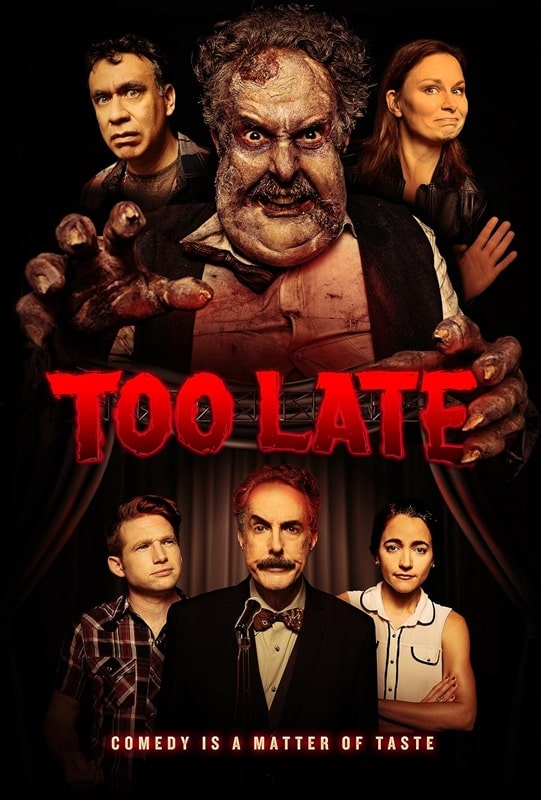

Too Late (Vanishing Angle, June 11, 2015) and Chawz (Lotte Entertainment, July 16, 2009)
Taking a break from gonzo Asian splatter-fests, I found myself settling in for what one might describe as a ‘cozy’ horror-comedy. Personally, I’d describe it as a missed opportunity, but a cursory glance at other reviews reveals I’m in the minority, so what do I know?
Violet (Alyssa Limperis) is the assistant to a famous stand-up comedian, Bob Devore (Ron Lynch), and she helps him find new talent for his late-night live show, Too Late. He doesn’t just need raw talent to entertain his crowds though, as Bob is a supernaturally old, shape-shifting monster that has to eat every four weeks. He’s been in the entertainment business a very long time, and only the most talented acts will sate his hunger. When Violet falls in love with one of his potential meals, she must find a way to terminate her contract and save herself. And that’s about the gist of it. A not-so-subtle allegory for the destructive nature of showbiz.
I’m good with this. It’s a solid concept and the film is well-shot and directed, and for the most part well acted. Fred Armisen and Mary Lynn Rajskub pop up for short cameos, mainly, I suspect, to help get the film funded and to put on the DVD cover, and the rest of the cast is filled out with the usual roster of genre types. They all do their jobs admirably. The horror itself is fairly tame, and other than a shot at the end, relatively bloodless, and I didn’t mind that either.
What I did object to though was the notion that this all takes place against the backdrop of a comedy club, and not a single one of the performers was funny. I get it. Comedy is subjective, but come on, some of this was the dullest observational humour I have ever heard. Not the main focus of the story, but it still irked me enough to get salty as I watched it.
Bottom line, OK.
5/10
Chawz (aka Chaw) (2009)The Korean title Chaw translates to ‘trap’, but this creature feature wears its influences on such a large sleeve, that it was rebranded to Chawz for its US release, capitalizing on that old shark movie.
I’ve been a sucker for giant, mutant boar movies ever since I first watched Russell Malcahy’s Razorback back in the day. Sadly, they are a bit thin on the ground, but this is a good one, so I’m glad I caught up with it.
It’s your usual monster movie fare; giant creature terrorizes a village, eats folk, is a bit of a nuisance etc., plucky group of tropes band together to hunt it down. So far, nothing new. However, this being a Korean film, it has to meet the 2 hour run time, so there is a lot more going on with a broad roster of characters. We have a fish out of water tale with Kim Kang-soo, a freshly transferred cop, a revenge tale with Chun Il-man wanting to avenge his grand-daughter’s savage death, some light comedy via a clutch of goofy cops and hangers-on, a doomed romance, a crazy lady, an incompetent official, etc etc.
It’s a lot to follow, and the film would benefit from a bit of pruning, but on the whole I had fun with it. The monster effects are fine; a combination of puppetry and B-tier CG, and there are plenty of homages littered throughout to prompt a drinking game.
It’s no The Host, but still worth a look.
7/10
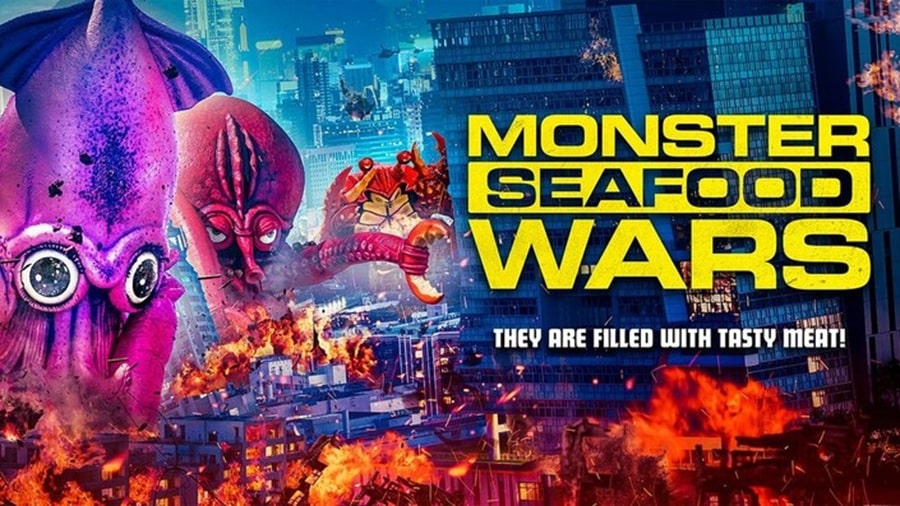 Monster Seafood Wars (Pal Entertainments, June 6, 2020)
Monster Seafood Wars (2020)
Monster Seafood Wars (Pal Entertainments, June 6, 2020)
Monster Seafood Wars (2020)
Never one to turn my nose up at a kaiju slam-fest, I started this one with some trepidation, and was wise to do so. It’s all rather maddening. Stuck inside this ‘comedy’ is a decent monster flick idea; a young slacker scientist creates a serum that can make creatures grow huge in an effort to cure world hunger. His invention is stolen by a nefarious rival, who also steals his shrine offerings (a squid, an octopus and a crab), which are then mutated to ridiculous size and promptly go on a rampage.
The aspect I really enjoyed was the fact that the populace discovers these kaiju are delicious, and so they are happy to let them fight while they control them with vinegar cannons, so that chunks get knocked off and turned into gourmet dishes. That’s what the story should have focused on — it’s a great hook that could allow some excellent moral dilemmas, but instead we have to wade through a tedious love triangle and unnecessary ‘mockumentary’ interviews with the witnesses to the shenanigans.
It also doesn’t help that the monsters themselves are cutesy mascot-style designs with googly eyes and fixed expressions. I wonder how awesome this film could be with realistic creatures and a focus on their deliciousness.
Oh well.
5/10

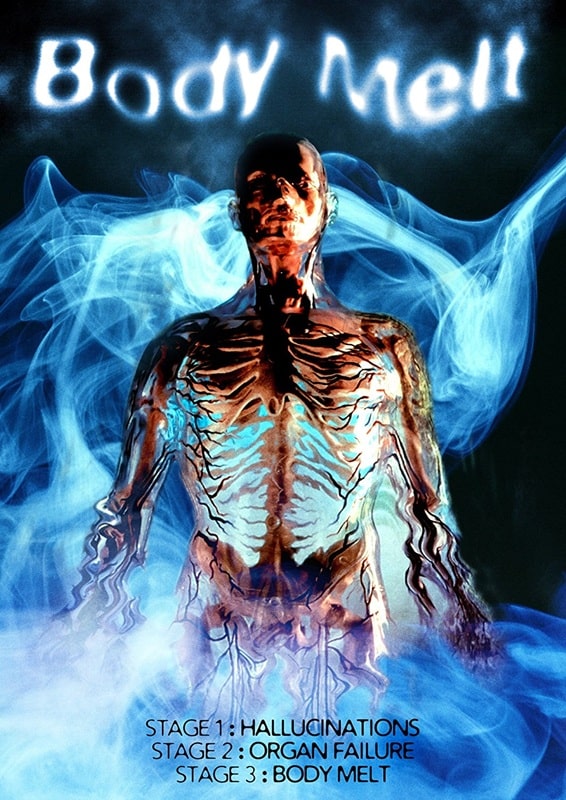
Blood Surf (Trimark Pictures, December 4, 2000) and Body Melt (Beyond Distribution, December 15, 1993)
If you know me by now, I’m always up for a killer crocodile/alligator flick, and when I learned that the late, great John Carl Buechler was responsible for the reptile effects, I got mistakenly excited.
You see, it’s a film about a hugely unlikable group of MTV brats who want to film themselves surfing with chum-crazed sharks, but instead get roped into a croc of shit. The effects are not good, lots of dodgy superimposition, and the filmmakers had no idea how to shoot the big croc puppet. The script is aggressively dumb, the actors deliver their stupid lines with zero interest, and the whole thing is a crushing bore.
What with a Jürgen Prochnow ordered off of Wish, a Matthew Lilliard/Seann William Scott hybrid, and two girls flashing their tits at the beast before one says, “I guess that’s what you call a croc tease,” I was done with it all.
The one single redeeming feature was that one character was called Melba, which allows me to make a ‘Melba was quickly toast’ joke.
Bah.
1/10
Body Melt (1993)Here’s a strange one from down under — a gonzo, sci-fi, body-horror goo-a-thon starring Ian (Harold Bishop from Neighbours) Smith as an evil doctor. Brilliant bit of casting.
The story is about an immoral pharmaceutical company that doles out free pills to the residents of a small community, and then records the various side-effects. Side effects include: exploding body parts (heads, willies, that sort of thing), sentient placentas, randomly placed tentacles, cannibalism, and various amounts of melting.
As you might be able to discern, there are no set rules to the side-effects, and this is the downside to the film. Rather than tell a coherent story, it plays out more as a series of gloopy vignettes, and we really don’t have a main protagonist to follow.
That said, it’s quite ridiculously fun, and there’s plenty of weird stuff going on (and one or two big laughs), so I’m recommending it to all the weirdos out there.
6/10
Previous Murkey Movie surveys from Neil Baker include:
Tubi Dive, Part I
Tubi Dive, Part II
Tubi Dive, Part III
Tubi Dive, Part IV
What Possessed You?
Fan of the Cave Bear
There, Wolves
What a Croc
Prehistrionics
Jumping the Shark
Alien Overlords
Biggus Footus
I Like Big Bugs and I Cannot Lie
The Weird, Weird West
Warrior Women Watch-a-thon
Neil Baker’s last article for us was Part IV of Tubi Dive. Neil spends his days watching dodgy movies, most of them terrible, in the hope that you might be inspired to watch them too. He is often asked why he doesn’t watch ‘proper’ films, and he honestly doesn’t have a good answer. He is an author, illustrator, teacher, and sculptor of turtle exhibits. (AprilMoonBooks.com).
6 Great Audiobooks You Can Enjoy (On audiobooks.com!)
In this LitStack Rec, we take a look at 6 great audiobooks. The voice performances…
The post 6 Great Audiobooks You Can Enjoy (On audiobooks.com!) appeared first on LitStack.
THE INCANDESCENT by Emily Tesh
Leviathan Limited Edition from Lividian
Signed, Numbered, and Slipcased Limited Edition
Includes cover and interior artwork by Vincent Chong
Just Announced and Selling Very Quickly!
Lividian Publications is proud to be publishing a deluxe signed, numbered, and slipcased Limited Edition hardcover of Leviathan by Robert McCammon, the final volume in his acclaimed Matthew Corbett series. This deluxe special edition tips the scales at more than 500 pages and has been lavishly crafted with collectors and readers alike in mind. Vincent Chong provided stunning color artwork for the dust jacket along with a full-color frontispiece and exclusive black and white illustrations for the interior!
Don’t forget that our books are also carried by some of our favorite small presses and retailers:
Bad Moon Books
Buchheim Verlag (Germany)
Camelot Books
Cracked and Spineless Books (Australia)
Jake’s Rare Books
Kathmandu Books
Midworld Press
Overlook Connection
SST Publications (UK)
Subterranean Press
Veryfinebooks
Ziesings
COVER REVEAL: Dragon Along (The Dragons of Nóra #2) by Joseph John Lee

Official Author Website
Preorder Dragon Along over HERE
Dragon Along ARC Sign-up Sheet
Joseph John Lee is an author whom we love at Fantasy Book Critic. He's the author of The Spellbinders & the Gunslingers trilogy. We were so thrilled to be a part of the cover reval for the concluding vlume of the Dragons of Nóra duology.
Dragon Along will be releasing on June 3rd 2025 & here's the cover in all of its glory and do checkout the blurb below

Official Blurb: Sometimes, the promise of a different story doesn’t quite go the way you planned.
After the adventure of a lifetime and hatching a dragon of his own, Camaráin promises his mother that they won’t be forced on the same journey his sister embarked on. That pledge appears to have happened a bit too literally: for as much as Camaráin’s hatchling Brían loves to sit and read with him, they share neither the Bond nor the friendship that Camaráin’s sister had with her dragon.
When his grandparents invite the family to their new home outside the capital city of Mór, Camaráin thinks the extent of his new story is getting rid of the belligerent gnome that has taken up residence in his grandparents’ bathroom. At least, until the gnome forms an instant rapport with Brían that leaves Camaráin flummoxed—and also quite jealous.
If Camaráin is to discover why he cannot form a Bond with his new dragon, he must navigate the strange webs of Mór spun by a secret scholarly society, a band of fae hunters, tourists taking up too much space, and the banned books section at the local library.
Evidently, the days of bonding over books and a cuppa have yet to make their way to the land of Nóra.
The Inheritance: Chapter 5, Part 1
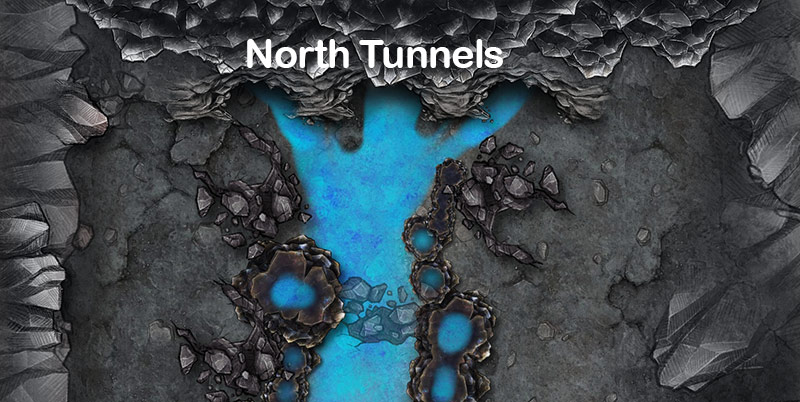
Note: commercial airlines fly at 30,000 feet. Private jets fly higher, with the midsize jets specifically flying at 41,000-45,000 feet.
The plane shuddered as it hit an air pothole. Elias put his hand on the maps spread out in front of him on the table to keep them from sliding off. Across from him, Leo sat very still, his eyes unblinking. His XO didn’t like planes. It wasn’t the flying; it was the lack of control. And if he mentioned it, Leo would just feel more self-conscious and withdraw deeper. Comfort and logic didn’t work for times like these, but distraction did wonders.
Elias turned his attention back to the maps. The sooner he sorted through his thoughts, the faster he could put Leo’s sharp mind to analyzing the Elmwood disaster instead of focusing on being stuck in a metal tube hurtling through the atmosphere 40,000 feet above the ground.
Gate dives had stages. Of all of them, the Assault phase was the main and most important. Humanity entered the gates to destroy the anchor and collapse the breach. Everything else was secondary to this goal, no matter how much some people wanted to twist it. Yes, mining paid the bills, but the focus of the mission was to keep the invasion at bay.
Like many others, Elias felt the anchor the moment he stepped through the gate. It tugged on him, a knot of energy, a distant nexus of power that demanded attention. The stronger you were, the more it pulled on you. Not every gate diver sensed it, and the majority of those who did barely felt it. To them it was a spark, a firefly winking somewhere in the distance. To Elias, it was inescapable, like an evil sun. It called to him, and he hunted it down until he cut through its defenders, forced his way into the anchor chamber, and shattered it.
The trick wasn’t just carving a bloody path to the anchor. The real challenge was to destroy the breach and come out alive. Successful gate dives required preparation. It began with the DDC, who measured the energy emissions of a gate, graded its threat level, and assigned a DeBRA and a guild.
Once Cold Chaos received the assignment, the gate became their problem. An assault team, a mining crew, and an escort was determined, and a gate coordinator was chosen to handle the logistics and keep everything running smoothly.
The assault team deployed to the gate and began the first official phase, the Survey. They progressed carefully into the breach and identified the most likely route to the anchor and promising mining areas. They cleared the mining sites, mapped as much of the immediate environment around them and the gate as was feasible, and came back out.
The next stage was called R&R: Rest and Regroup. Each breach was unique. Open air biomes required larger groups. Cave biomes called for a smaller force with higher individual firepower. Some people didn’t do well in dark enclosed spaces. Others couldn’t swim or had trouble with heights. The assault team reshuffled its roster based on their findings. They reviewed their survey with the escort captain, the mining foreman, and the DeBRA, and then they rested for 24 hours.
After the R&R, the Assault stage finally began. The assault team went back into the breach, swept the mining site one more time, sent a scout back to give the mining team an all-clear, and pressed on toward the anchor. An hour after they entered, the mining crew, the DeBRA, and the escort walked into the breach, made their way to the mining site, and began stripping. A rich site would mean a steady flow of carts filled with resources out of the gate.
If everything went according to plan, the assault team would reach the anchor and destroy it. Without the energy of the anchor, the breach would begin to degrade. The assault team would have to haul ass to the gate, usually sending a scout ahead to warn the mining team to wrap up operations. The breach typically collapsed within 12-36 hours.
That wasn’t what happened in Elmwood.
Radio communications did not work in the breaches, so every assault team carried a “cheesecake,” a beeper stone. Beeper stones occurred in the steppe and mountain biomes and had a core of denser material running through them. When shocked with electricity, they glowed and vibrated. If you broke a piece off and then shocked the core of the main stone, the broken-off piece would also light up and vibrate. Distance didn’t seem to matter. As long as both fragments were in the same breach, shocking the core would activate the other chunk. The first gate diver who discovered this effect compared it to the Cheesecake Factory’s restaurant pager and the name stuck.
The moment the cheesecake was activated, the assault team would know that a fatal event occurred, and they were being recalled. It was the breach equivalent of an SOS. They would turn around and head back for the gate.
The mining crew died less than an hour after entering the gate. As soon as London and the rest made it out, the gate coordinator went into the breach with the core stone, shocked it, and then returned to shock the core stone every half hour for three hours. The assault team was barely two hours into their trek to the anchor. They never came out. It meant only one thing: everyone was dead.
Elias peered at the mining site map. Compasses didn’t work in the breaches, so traditional directions didn’t exist. Instead, the moment you entered, you faced north and the gate behind you was always due south. It was obviously simplified but it worked, and all breach maps followed this principle.
The cave biomes were Elias’ least favorite, and this one was a fucking maze. A tangle of tunnels, passages, and chambers, resulting from eons of erosion as water shaved and carved the stone.
Some people theorized that the breaches were artificial, generated environments, constructed specifically to invade Earth. He never believed in the artificial breach theory. It was bullshit. He’d gone into too many breaches and seen too much. The complexity of the bio systems they encountered was incredible, far too intricate for any artificial construct. No, the breaches were chunks of some other world, maybe worlds, complete with their inhabitants and their own weird rules of survival. And this breach was a perfect example of that. It was old and filled with valuable deposits and extremely dangerous hostiles.
On the surface, Malcolm, the leader of the assault team, had followed the Cold Chaos protocol. The assault team surveyed, they R&R’d, they reentered and swept the mining site for the second time, then started toward the anchor. But the more Elias looked into what actually happened, the wonkier it appeared.
The map in front of him showed Malcolm’s chosen anchor route, which ran almost straight north into the breach. The mining site lay off to the east, roughly a mile from the gate, at the end of a branching tunnel. It was a massive cavern with a stream running north to south. The map showed an entrance in the lower left, through which the mining crew accessed the site, and three tunnels in the north, at the top of the map. The assault team had mapped the tunnels up to half a mile, revealing a tangle of passageways, pits, chambers, and tunnels, half of them carrying running water.
Map of the Mining Site
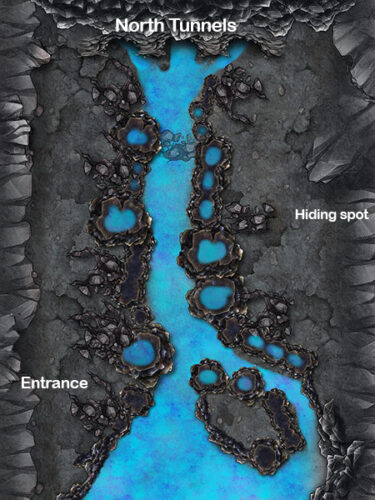 Click to enlarge
Click to enlarge
Determining a good mining area was more art than science. The Cold Chaos guidelines for cave biomes dictated that only the larger caverns could be designated as mining sites. The guild lost too many people in tunnel collapses. The mining site had to be safe and defendable, it couldn’t be too far from the gate, and it had to have a good mix of promising minerals identifiable by sight and an abundance of vegetation in case the minerals turned out to be trash. The weirder the site looked, the more promising it would be.
Things would have been so much simpler if they could hire their own assessors, Elias reflected. As it was, they were forced to play the guessing game. That’s why most assault teams identified at least 3 sites.
Malcolm had only picked one.
Elias examined the top edge of the cavern one more time.
Nothing in this world was free. They were never going to go into a breach with fluffy bunnies and rare, priceless resources. The unspoken rule was, the more valuable the find, the harder it would be to extract. Malcolm knew this. He wasn’t sloppy, he wasn’t careless, and yet here they were.
Elias looked at Leo. His XO leaned forward slightly.
“You are Malcolm,” Elias said.
Leo nodded.
Most people assumed that the tank was always the leader. Something about a warrior putting themselves in the path of a threat and soaking up damage while shielding others naturally lent itself to the leader role in people’s imagination. In reality, tanks were almost always too focused on combat to be effective leaders. They were the tip of the spear, and they usually had their hands full.
His own Talent, the Blade Warden, straddled the line between a tank and a damage dealer. He could play either role. On paper, he paid for this versatility with reduced effectiveness. A pure tank Talent, like Sentinel or Protector, of the same power level, could take more damage than Elias. A pure damage dealer, a Pulsecarver or a Stormsurge like Leo, would wreck more havoc. But in the breach, the value of his versatility skyrocketed. He had led teams while tanking – he would do it again in Elmwood – but given a choice, he preferred to go in with a dedicated tank.
Most team leaders were either midfielders or ranged fighters. The ability to survey the terrain was paramount.
Malcolm was an Interceptor, a maneuverable, fast damage dealer. He positioned himself behind the tank, which allowed him to rapidly respond to the changing battlefield. He fought with a spear, could summon plasma javelins, which he hurled at incoming threats, and could teleport about twenty yards once every hour or so.
The man had an uncanny situational awareness. He was slightly precognizant, anticipating the enemy’s actions as well as his team’s. He could predict how and where an opponent would attack and how his people were likely to respond to it. He sensed when someone would need assistance, and he was always where he was needed the most. His only flaw as a team leader was that occasionally he made impulsive decisions. Nine times out of ten, he reacted as expected but once in a while he would roll the dice. To his credit, he was good enough to compensate when his gamble didn’t pay off, but he’d come close to disaster a couple of times.
Elias tapped the map of the mining site. “You find this site. You sweep it. It’s clean. Your next move?”
“I set up aetherium charges in these three tunnels and detonate.”
Exactly. “Why?”
Leo swept his fingers across the three passages veering and branching off, some paths spiraling, others ending abruptly.
“It’s a mess. Everything is connected. The only way to secure the mining site is to prevent access completely. One way in, one way out.”
“Agreed. Malcolm would have known that.”
“Yes.”
The two of them peered at the map. This was basic shit, and yet Malcolm left the tunnels as they were.
“Why?” Elias murmured.
“I don’t know.”
“What’s your best guess?”
Leo considered the map. “Perhaps he was unsure whether he picked the right path to the anchor and thought he might have to double back and take one of the tunnels instead.”
“Yes, but with the firepower in that team and the mining crew’s equipment, he could easily reopen one of the entrances after collapsing it. Why gamble with the miners’ lives?”
Leo shook his head. “I don’t know.”
“Next question: why only one mining site? The protocol suggests at least three. Why this one?”
Leo thought about it. “You think he found something in that cave? Something he had to have?”
“That’s the only thing that would make sense.”
In Malcolm’s place, Elias would have spent another three days on a survey and then doubled back and collapsed those tunnels. Then and only then would it have been safe to bring in the miners. Yes, there would be red tape, and they would have to explain to the DDC why they took their time, but in the end, lives wouldn’t be lost. Instead, Malcolm charged in, pushing the mining crew to the site as soon as the guild regulations allowed.
Leo eyes flashed white. The moment he was left to his own devices, he would take a deep dive into Malcolm’s life. Leo took mysteries as a personal challenge,
Elias leaned back. “Let’s say Malcolm glitched out for some reason. He gets impulsive once in a while, but London doesn’t.”
Leo nodded. “London is careful and risk averse.”
Risk averse. Interesting way to put it. Elias would have to remember that.
The XO frowned. “When the team came out with the survey, London would’ve had to sign off on it. He is the escort captain.”
“Exactly. Did you ask him about it?”
“No. It didn’t occur to me.” A hint of frustration showed on Leo’s face. He was his own worst critic. “I should have. It seems obvious in hindsight.’
The intercom came to life. “We’re beginning our descent into Dallas.”
“Don’t worry too much about it,” Elias said. “London isn’t going anywhere. In a few hours we will ask him about that. And a lot more.”
Leo nodded and buckled his seat belt.
The post The Inheritance: Chapter 5, Part 1 first appeared on ILONA ANDREWS.
Comment on A Beginner’s Guide to Drucraft #36: Essentia Capacity In Practice by Benedict
In reply to Kevin.
There’s no such thing as a Primal sigl that increases your essentia count. There are ones that let you store personal essentia, which lets you simulate a higher essentia capacity, but you don’t get something for nothing – you have to pay that essentia in first (and it’ll de-attune quickly unless you do something to stop it). Also, if your plan is to use multiple sigls at once, you have to actually have enough channelling skill to make effective use of them, which a lot of people don’t.
Comment on A Beginner’s Guide to Drucraft #36: Essentia Capacity In Practice by Kevin
In reply to Benedict.
Ah I should have clarified better!
I meant could you activate a strong enough Primal sigl to increase your essentia count, so you could activate three more. Thus using four activated sigls at once.
But I am guessing from your answer that is not feasible for most Drucrafters unless in cases where you have 2.8 or above Essentia Capacity where that is practical.
Tor Doubles #5: Poul Anderson’s No Truce with Kings and Fritz Leiber’s Ship of Shadows
 Cover for No Truce with Kings by Royo
Cover for No Truce with Kings by RoyoCover for Ship of Shadows by Robin Wood
Both Poul Anderson’s No Truce for Kings and Fritz Leiber’s Ship of Shadows originally appeared in issues of The Magazine of Fantasy and Science Fiction, Not only did their initial publication occur in the same periodical, but both of those original issues sported covers painted by Ed Emshwiller.
No Truce for Kings was originally published in F&SF in June, 1963. It won the Hugo Award and received a Prometheus Hall of Fame Award in 2010. No Truce for Kings In is the first of three Anderson stories to be published in the Tor Doubles series.
Colonel James Mackenzie is the commander of Fort Nakamura in a post-apocalyptic California who receives a message that Judge Brodsky has been deposed and replaced by Judge Fallon. This message is the indication to Mackenzie that a civil war has broken out. Although Mackenzie and his troops are loyal to the old regime, the letter makes it clear that Mackenzie’s son-in-law, Thomas Danielis, is aligned with the rebels, as well as serving as a hostage for the troops who are coming to relieve Mackenzie of his command.
The story alternates between Mackenzie’s and Danielis’ actions in the subsequent war, and although Anderson includes many indicators of what the old regime looked like, with a series of local feudal lords called bossmen, and the attempts to destroy that society by the forces of Fallon and his allies, the use of time jumps throughout the story give it a somewhat disjointed feel. However, the use of a Mackenzie and Danielis, as relatives, along with the occasional appearance and frequent mention of Laura, Mackenzie’s daughter and Danielis’ wife, as well as her pregnancy and the birth of her child, combine to give the discussions of tactics and strategies a more personal flavor throughout the story.
While No Truce for Kings starts out as a pretty generic post-apocalyptic story, Anderson adds in an alien element that sets it apart. His aliens, who mostly appear in conversation with themselves as observers of the actions of the humans seem as if they are a response to the psychohistorians of Isaac Asimov’s Foundation series, which was originally published twelve years before No Truce for Kings. These aliens make use of psychodynamicism to guide the events of the humans as they come out of the fall of civilizations. Furthermore, while Asimov created the religion of scientism to help guide the galaxy, Anderson’s aliens have introduced Espers, people who ostensibly have psychic abilities.
The interludes have only a minor direct impact on the action of the story, but they allow Anderson to provide the information the reader needs so the main characters can continue interacting with their world without providing a data dump and allows the reader to have additional background knowledge they don’t have. When Mackenzie comes into contact with a group of Espers, who are theoretically neutral in the war between Fallon and Brodsky, the information Anderson has provided in the discussion of his aliens provides more depth to the Espers’ actions that may seem odd to Mackenzie but can be explained away, except the reader has an understanding where he has gone wrong.
Anderson doesn’t just place Danielis and his father in law on opposite sides of the war, he provides them with a reason for being on those sides. Mackenzie grew up in the system of bossmen and thrived because of it. To him it was the natural order of things. Danielis was an orphan who had to work his way up through the system, eventually succeeding in a military career. He was helped along the way by the Espers, and although they were officially neutral, there is no point in the story that it doesn’t seem like common knowledge that they are supportive of Fallon’s rebellion.
Eventually, of course, the existence of the aliens becomes known and changes the course of the war. The forces of Fallon and Brodsky, all of whom are aware that there was once a more unified country that had collapsed and all of whom have hopes to reestablish in their own ways, suddenly become aware that there is more out there, and can offer them a higher level of technology than humans had previously had access to. This is an area that Anderson had previously explored in works like The High Crusade, published three years before No Truce for Kings. Although Anderson addresses the dichotomy of science, it is done in an almost cursory manner, providing the story with something of an anticlimax from that point of view.
At the same time, his decision to follow Danielis and Mackenzie throughout, focusing on their experiences and the stresses caused by the knowledge that they were on opposite sides of the civil war, imbues the story with a human connection that ultimately does come to a satisfying conclusion, even if the situation does not allow for a happy outcome for all who are involved.
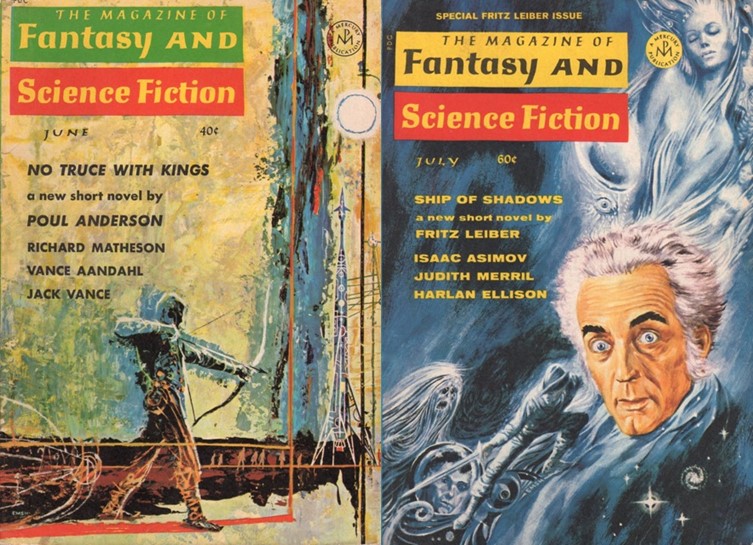 Fantasy and Science Fiction 6/63 cover by Ed Emshwiller
Fantasy and Science Fiction 6/63 cover by Ed EmshwillerFantasy and Science Fiction 7/69 cover by Ed Emshwiller
Ship of Shadows was originally published in F&SF in July, 1969, which was an issue dedicated to Fritz Leiber and included a portrait of him by Ed Emshwiller on the cover. The issue included essays on Leiber by Judith Merril and Al Lewis as well as a reprint of Leiber’s recent poem “iix. ‘Out the frost-rimmed windows peer,…’” and this original novella. Ship of Shadows was nominated for the Hugo Award and the Nebula Award, winning the former. Ship of Shadows is the first of four Leiber stories to be published in the Tor Doubles series, including two that would be published in the final official release of the series.
There is a saying that science fiction (and fantasy) stories have to teach the reader how to read the individual story. The readers must be taught which words should be taken literally and which can be understood metaphorically. Nothing about the story’s setting can be assumed and the reader should allow the author to explain where the story is taking place. Leiber is more than happy to keep the reader in the dark about the actual location in which Ship of Shadows takes place, only revealing the details slowly.
The reader’s entry into this world is Spar, an older man who works as a bartender at the Bat Rack, a dive which serves moonmist, a low grade alcohol. Spar is accompanied by Kim, a talking cat who seems to be his closest friend, although Spar also has a connection with his boss, Keeper, and several of the bar’s patrons, ranging from Doc to Crown to the various women who frequent the bar. Those relationships range from awkwardly cordial to almost adversarial.
Spar has bad teeth and can barely see. He prefers to stay in his menial job at the Bat Rack rather than explore the world around him, taking comfort in the known space, even though it is relatively clear to the reader that even those who seem to have affection for Spar do not respect him or see him as an equal. Even Kim appears to view Spar more as a means to an end.
The world he inhabits appears to be one in which witches and zombies move with impunity, a four day week is in place which includes days for work, idleness, play, and sleep. The world, referred to as Windrush, may also be a ship of some sort, although the characters are not fully aware of its nature. How much of Spar’s knowledge of his world is accurate, how much is legend, and how much is authorial misdirection only becomes partially clear as the novella continues.
Just as Spar seems to have a limited understanding of the world in which he lives, Leiber isn’t in any hurry to provide the reader with any details. It isn’t until he is sent on an errand by Keeper that the world begins to come into an sort of focus, perhaps reflective of the fact that during the errand Spar plans to make a stop to see Doc and have him provide Spar new teeth and new eyes. In his travels, Spar discovers a that Windrush has a variety of different neighborhoods which don’t quite mesh with the world he has pictured living and working in the Bat Rack.
His travels take him to the Bridge, a world of “irregularly pulsing rainbow surfaces, the closest of which sometimes seemed ranks of files of tiny lights going on and off—red, green, all colors. Aloft of everything was an endless velvet –black expanse very faintly blotched by churning, milky glintings.” This revelation, which will be recognized by readers, is strengthened by the fact that it is described through Spar’s imperfect eyesight, which further reinforces the idea that, through no fault of his own, Spar’s impressions of his world of unreliable.
Because of the amount of information Leiber keeps hidden from the reader (and his characters), Ship of Shadows is the sort of work that benefits from re-reading. The first pass lives the reader at a loss for much of the story, but once the explanations come late in the tale, they can illuminate the earlier action when read with the knowledge of what Leiber will eventually reveal.
The cover for No Truce for Kings was painted by Royo. The cover for Ship of Shadows was painted by Robin Wood.
 Steven H Silver is a twenty-one-time Hugo Award nominee and was the publisher of the Hugo-nominated fanzine Argentus as well as the editor and publisher of ISFiC Press for eight years. He has also edited books for DAW, NESFA Press, and ZNB. His most recent anthology is Alternate Peace and his novel After Hastings was published in 2020. Steven has chaired the first Midwest Construction, Windycon three times, and the SFWA Nebula Conference numerous times. He was programming chair for Chicon 2000 and Vice Chair of Chicon 7.
Steven H Silver is a twenty-one-time Hugo Award nominee and was the publisher of the Hugo-nominated fanzine Argentus as well as the editor and publisher of ISFiC Press for eight years. He has also edited books for DAW, NESFA Press, and ZNB. His most recent anthology is Alternate Peace and his novel After Hastings was published in 2020. Steven has chaired the first Midwest Construction, Windycon three times, and the SFWA Nebula Conference numerous times. He was programming chair for Chicon 2000 and Vice Chair of Chicon 7.
Bewitching the Orc Chief - Book Review by Voodoo Bride
 Bewitching the Orc Chief (Silvermist Mates #1)by Chloe Graves
Bewitching the Orc Chief (Silvermist Mates #1)by Chloe GravesWhat is it about:The most potent magic is sealed with a bite.
MirandaAll I wanted was one night of normal after a year of... avoiding my former coven. Instead, I got an orc chief who took one look at me and growled "mine." One scorching night later, I wake up in his village—which is definitely not what I had in mind for the morning-after.
Now I'm surrounded by suspicious orcs, trying to keep my magic under wraps, and fighting an inconvenient attraction to my very large, very possessive "host." But hey, at least my familiar likes him—the traitor.
OsenThe clan elders demand I take a mate to secure my position as chief. I didn't expect fate to hand me a witch who makes my blood burn and my instincts roar to mark her again. And again.
Our shaman spits venom about dark magic, while my uncle circles like a vulture. But when my brother lies bleeding out and her forbidden power yanks him back from the brink, I know I'll burn down tradition to keep her.
Then her coven tracks her to my mountains, and I discover exactly what kind of darkness my mate has been running from. They want to drain her magic and steal her power—but they'll need to go through me first.
My mate. My witch. And I'll destroy anyone who tries to take her from me.
What did Voodoo Bride think of it:I really enjoyed Vexing the Grumpy Orc, so I decided to get the other books in this series as well. So after starting this series with book 3, now it was time for book 1.
If I had started with this book it would have been immediately clear this is Urban Fantasy Romance. The Orc village feels really Other World Fantasy, but outside of their village things are modern. This book made that immediately clear, where book 3 took some time to get away from the village.
I liked the overall story and romance well enough, but this romance had one major turn-off: How much Osen kept mentioning his brother during one of the steamy scenes. I mean: if anyone would do that with me, I'd be out of there, Mate or not. I usually am not one to skim steamy scenes, but here I totally did.
That aside: I liked the book well enough, but I didn't connect with Osen or Miranda as much as I did with Galan in Vexing the Grumpy Orc. I still liked it enough that I'll read book 2 soon.
Why should you read it:It's an enjoyable Orc Romance


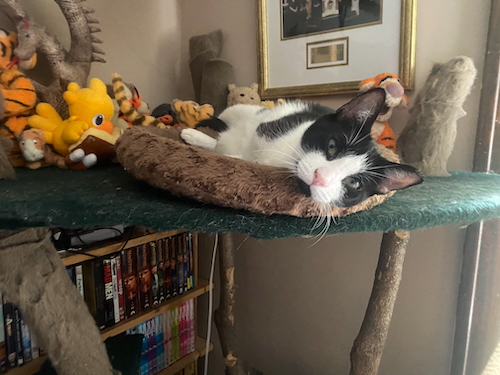





Recent comments